


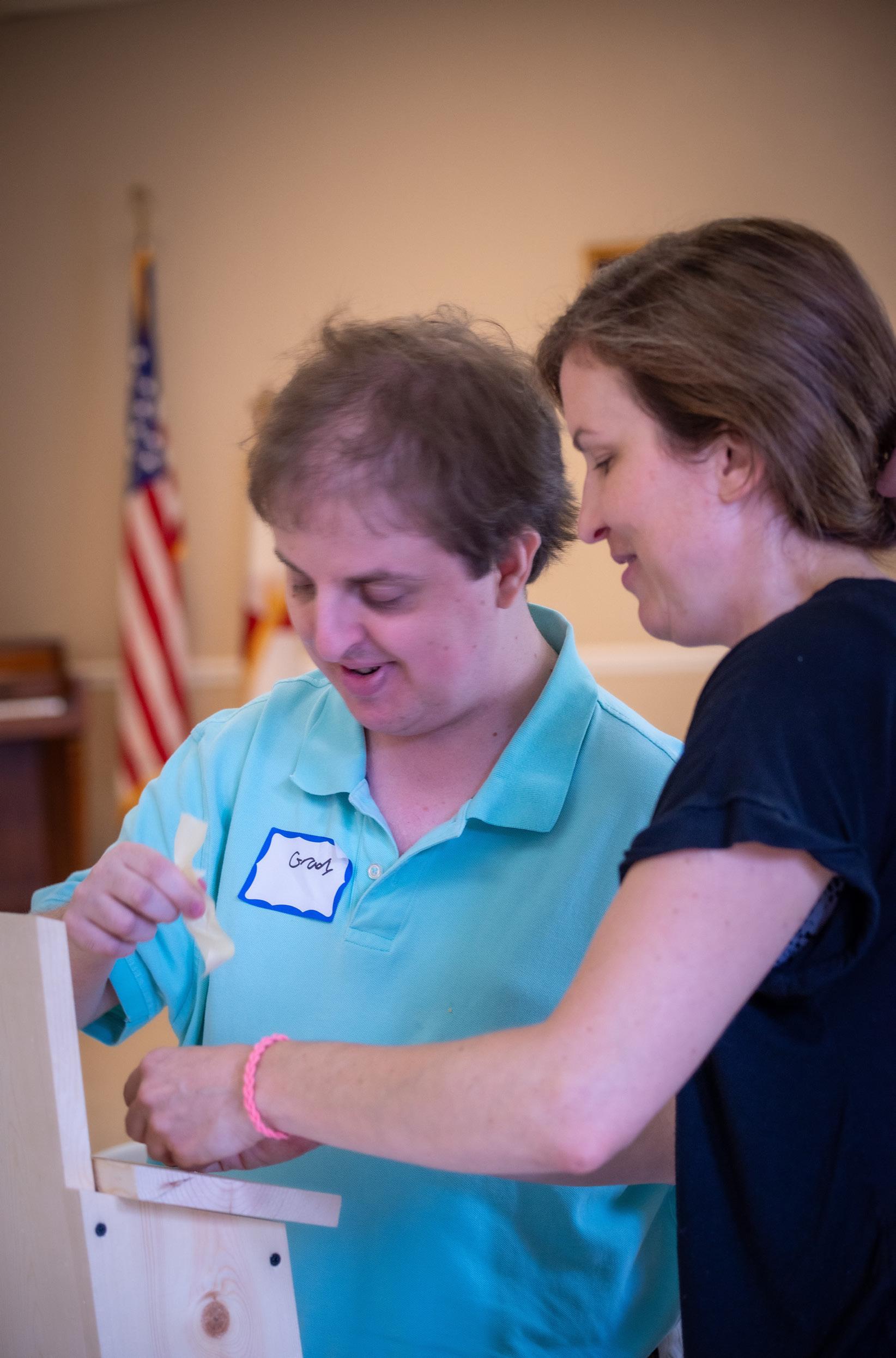
Coming Alongside Stories of Congregational Vitality in our Diocese: Behold, I Will do a New Thing: The Many Colors Art Collective 8 Setting the Table for the Everyday Eucharist 12 Welcoming and Being Welcomed 14 3RD QUARTER | VOL. 108, NO. 3 THE EPISCOPAL CHURCH IN ALABAMA
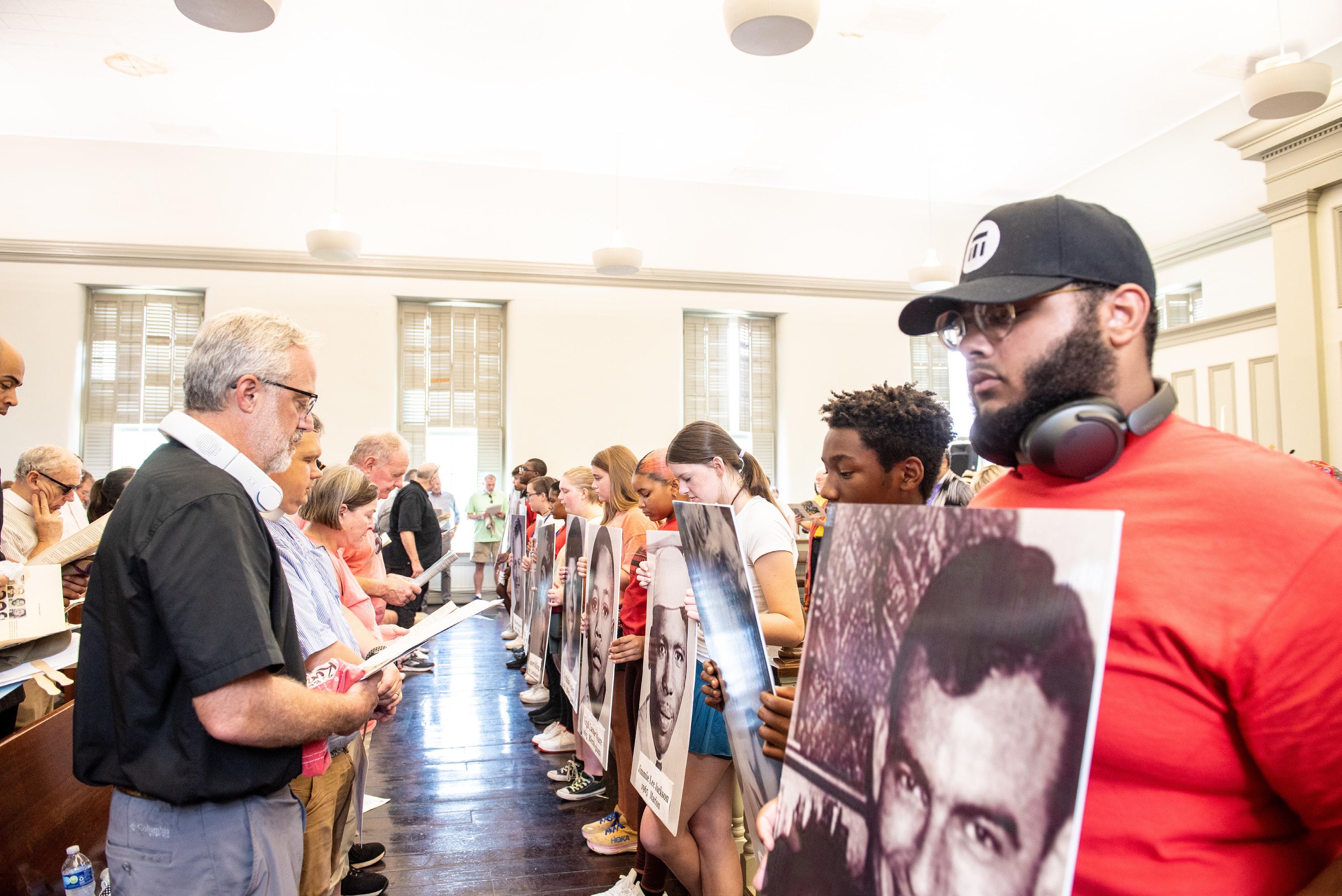
2 THE EPISCOPALIAN

DIOALA.ORG 3

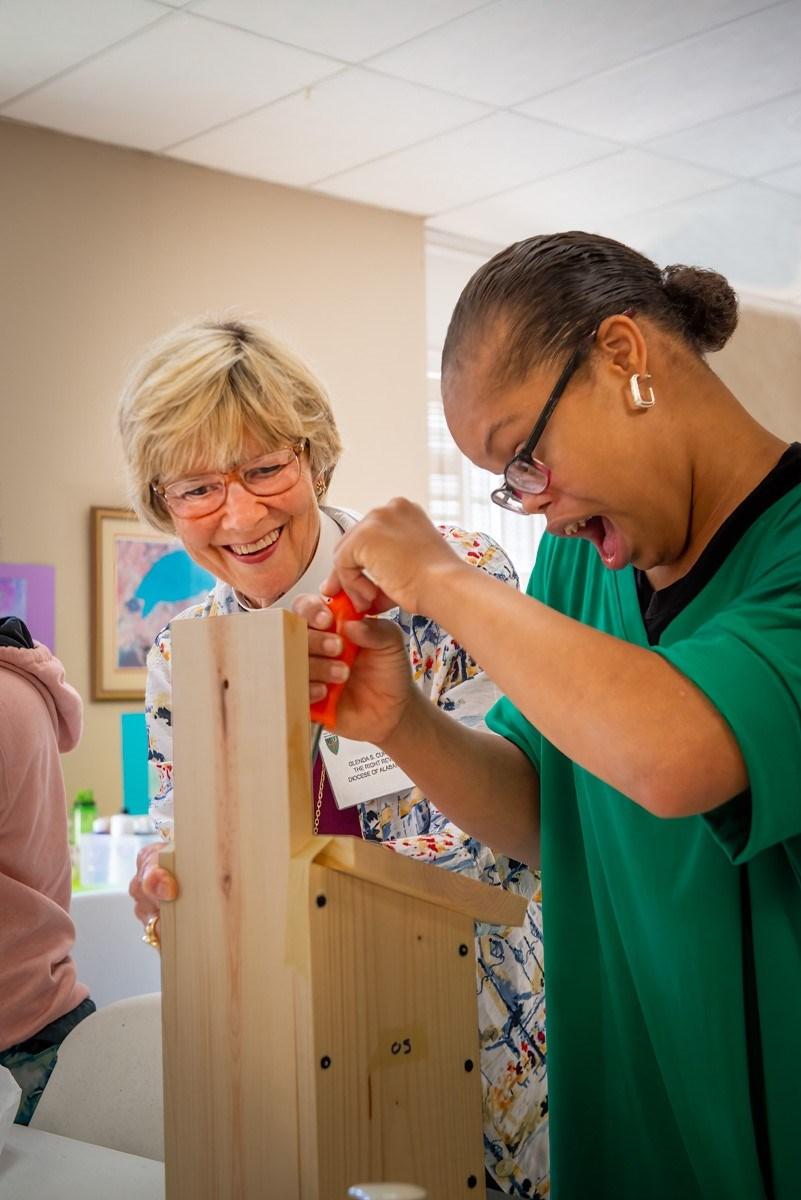
4 THE EPISCOPALIAN
Dear Friends:

A new school year has begun and everywhere I turn I see something posted about a new beginning. Everything from football to high school, middle school, college and even preschool is kicking off a new season, signaling the end of summer. Since our parish life follows the rhythm of the school year, I’m excited about all the ‘new beginnings’ happening around our diocese. Years ago, a good friend gave me a plaque that reads, “all beginnings are difficult”. I think it was meant as encouragement, because any new beginning in life usually comes with both ups and downs. New beginnings remind me that God calls us to create.
One of the joys and challenges of my work as bishop is discovering ways we can encourage a parish that’s trying to reach out beyond its walls. We know that a congregation’s vitality is stimulated and nourished when they try something new, especially when they’re bearing witness to the gospel. Just before Jesus goes to the cross, he promises the disciples he will not leave them orphaned. He promises to send a comforter, advocate, helper, namely the Holy Spirit to “come alongside” them as they try to live each day without Jesus’ physical presence. In the past year, our staff has offered to “come alongside” several congregations in the Diocese as they’ve experimented with new ways of sharing the gospel with their communities. In our walk with them we can see the Holy Spirit working all around and bringing life.
In this issue of The Episcopalian we’ll highlight some ways we’re sharing the gospel in the world. Several parishes are exploring who they are, examining their ministry, looking for ways to make their doors wider, their voices louder, and the love they offer more visible to those outside their walls. The work I’m seeing is inspiring, and I think we’re applying some of what we learned during the pandemic about experimenting.

After much prayer and planning, Church of the Holy Comforter in Montgomery recently opened a new way of reaching out to families with special-needs adults. They call their new ministry “Many Colors Art Collective”, featured in this issue. I joined in their classes one morning in late July, and several of the young adult artists taught me about building and decorating bird houses. Parishioners from Holy Comforter, Church of the Ascension and churches of other denominations across Montgomery mentored us in the work.
In spite of their smaller size and limited resources, the leadership of Holy Comforter decided to risk creating this new ministry. When they learned that many support services for special-needs adults closed during COVID, they felt the Holy Spirit calling. For nearly three years, the leadership has been actively discerning and looking for ways to share their facilities and develop new ministry with the world outside their church. The parish also co-sponsors a weekly food bank in their underused former day school with a nearby Presbyterian church. The congregation says these new directions are important new beginnings for their church. Practically every active member is participating and serving. It’s amazing to behold.

Have you ever heard about murmuration? Someone shared a video with me about the murmuration of the starlings. In highly uncertain environments, when the future is not clear, the birds fly together in an amazingly coordinated way without flying into each other. They swoop and move in a cohesive group. They manage uncertainty and maintain consensus about direction using something called the role of seven. Each bird pays attention to seven of their neighbors until they decide where to land. Considering seven other birds keeps them in a dynamic connection to the flock. Remember Jesus said, “consider the birds of the air” and don’t worry. If baptism connects us to love in Christ, it also connects us through love to each other in a mysterious web called the Body of Christ. In uncertain times, the gift of the Body of Christ helps us decide where we should land.
We are called to bear witness, whether we’re welcoming students to St. Paul’s, Selma’s newly renovated Common Ground House, reaching out to the community at the Abbey’s new home, worshiping with friends and strangers around the country in a big arena, in Navajoland, or on the streets of Hayneville, Montgomery and Camp McDowell, because when it comes to Jesus, it is all about love. As Christians, we are about bearing witness to the hope that is in us, the love given to us, because of the life-saving, lifegiving, love of Jesus which makes us One flock with One Shepherd. Thank you all for your ministry, for sharing your gifts and for your prayers.
As always, I am honored to be your bishop and I hope I see you soon at church!
5
s I walked down the road at camp, I was greeted by the excited faces of campers, sitting in their cars getting ready to register for Special Session. Their pure joy for the opportunity to be at Camp McDowell was infectious! After an endless series of high fives, I began to make my way to lower camp. As I approached the 'fork' I could hear the sounds of young people enjoying all things camp. Making my way down the hill, every direction I looked were kids - well - being kids! Their energy was palpable and all I could think is what a blessing it is to have such a wonderful place like Camp McDowell where young people can gather for fun, fellowship, and faith formation.
And while I could have hung out with the kids all day, I had one more stop on this fabulous day in God’s Backyard. Joining the sea of brightly dressed folks making their way into St. Francis I found myself surrounded by beloveds on their way to a special worship service. Special Session, Summer Camp, Cursillo all happening at the same time - the Spirit is alive and well, and very active in God’s Backyard!
All of this to say, Camp McDowell continues to consistently provide a container for spiritual transformation for all sorts of folks, each and every day, year around. And we continue to be blessed with a very hard-working, competent staff, and lots of extremely capable volunteers.
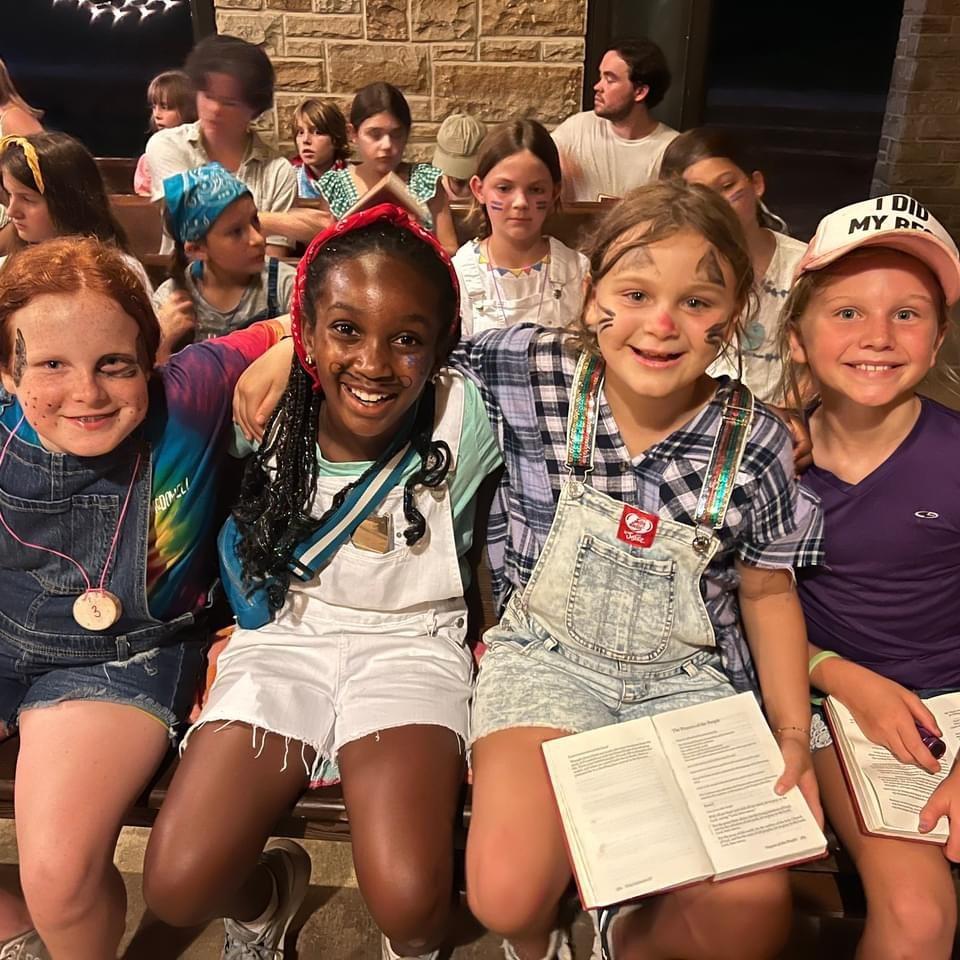
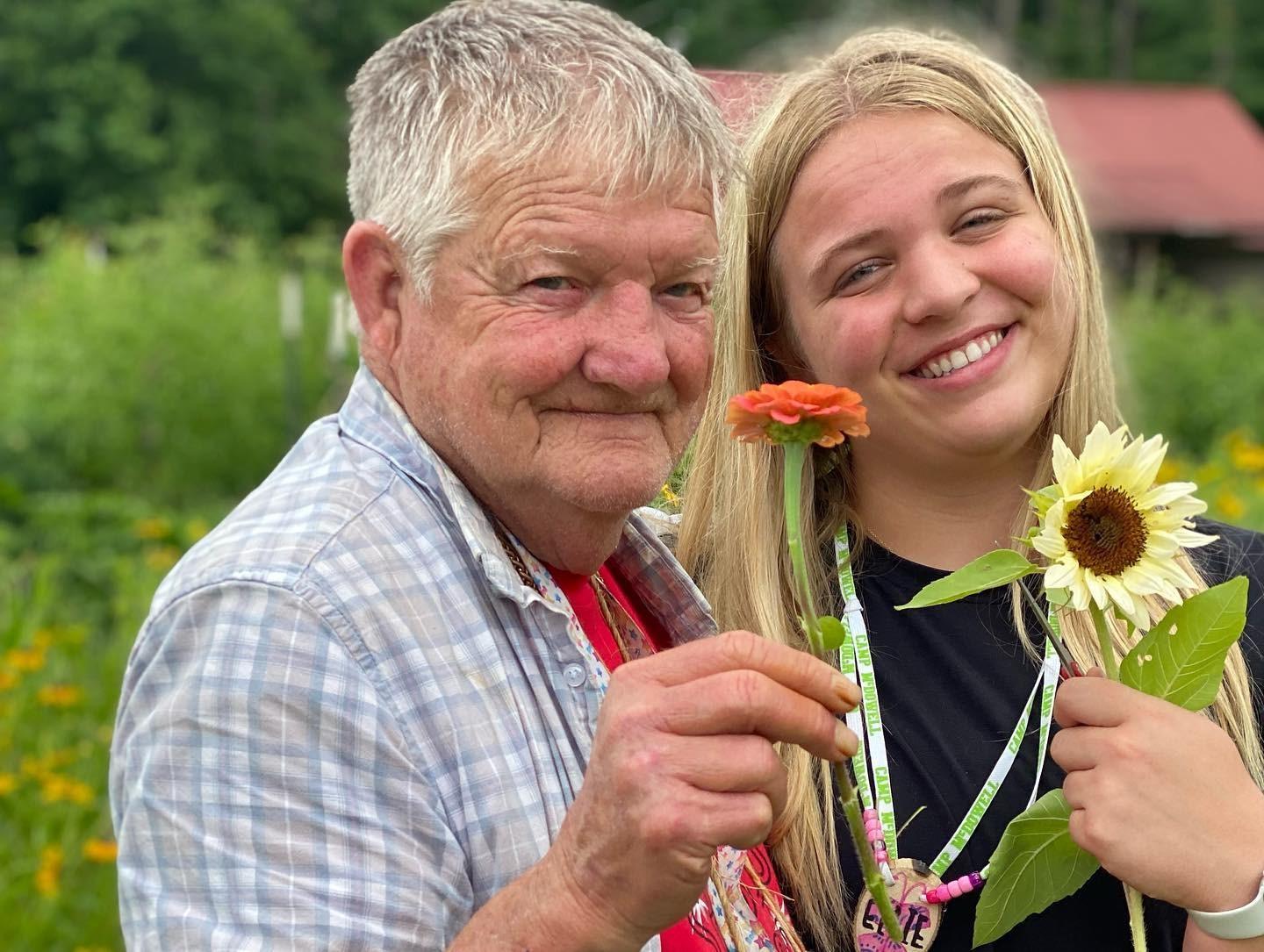
Amidst all the great things presently happening at camp, we continue to move ahead in our discernment for the leadership for the next season at Camp McDowell. After holding multiple listening sessions, the Bishop and the Council have reviewed those findings and the job description for the next leader of camp. Post Labor Day we will begin a nationwide search looking both near and far for who God is calling to join with the Bishops, Council, Camp Department, Camp Staff and all of us at Camp
Please



6
continue to pray that all will be open to the movement of the Holy Spirit as we seek the next leader of Camp McDowell.
CONGREGATIONAL


Over the past couple of years, diocesan staff have been analyzing the data and the life of our congregations in the hope of learning more about why our growing congregations grow. By combining what we are learning with some of the current scholarship about church life we have identified six trends:

1. Consistent measurement
2. Quality music
3. Warm leadership
4. Community engagement
5. Active discipleship
6. Willingness to experiment.
In this issue of The Episcopalian, we are sharing stories of both community engagement and a willingness to experiment. To be clear, those are necessary but ungainly descriptions of where the Lord is leading us in these specific instances. The truth of these ministries is much richer and transformative than a trend can describe. These are stories of what Sam Wells describes as the “heart edge” nature of our faith in Christ, meaning that the Church finds the heart of its mission at the edges of society and culture. And at that heart edge “God gives the church everything it needs, and often in the form of people it finds there.”1 We hope that you are moved by these heart edge stories of community engagement and faithful experimentation and that you will share your own stories of the same.
In following issues, we will be highlighting the other trends of Episcopal growth in Alabama and other instances of how these trends are being lived out in our diocese.
1 Wells, Samuel. Finding Abundance in Scarcity, ed. Samuel Wells (London: Canterbury Press, 2021)
We would love to learn more! Please email details to The Rev. Geoff Evans, gevans@dioala.org, or Debbie Donaldson, ddonaldson@dioala.org.
DIOALA.ORG 7
The photos in this article were taken when Bishop G visited Holy Comforter and the Many Colors Art Collective in July. The artists built and painted bird houses, which were featured in an art show held in early August. Each participant was given personalized business cards to use at the show.
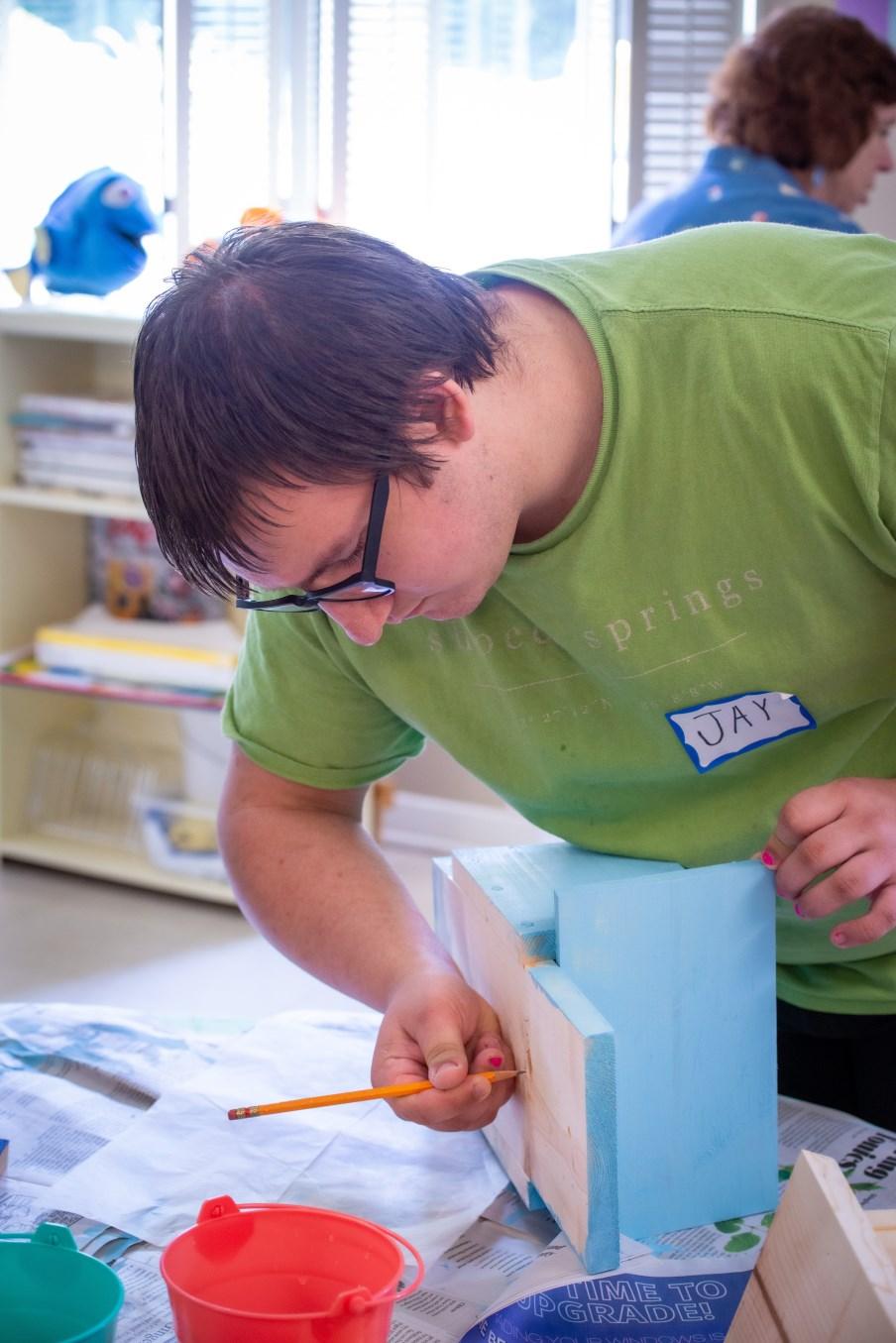
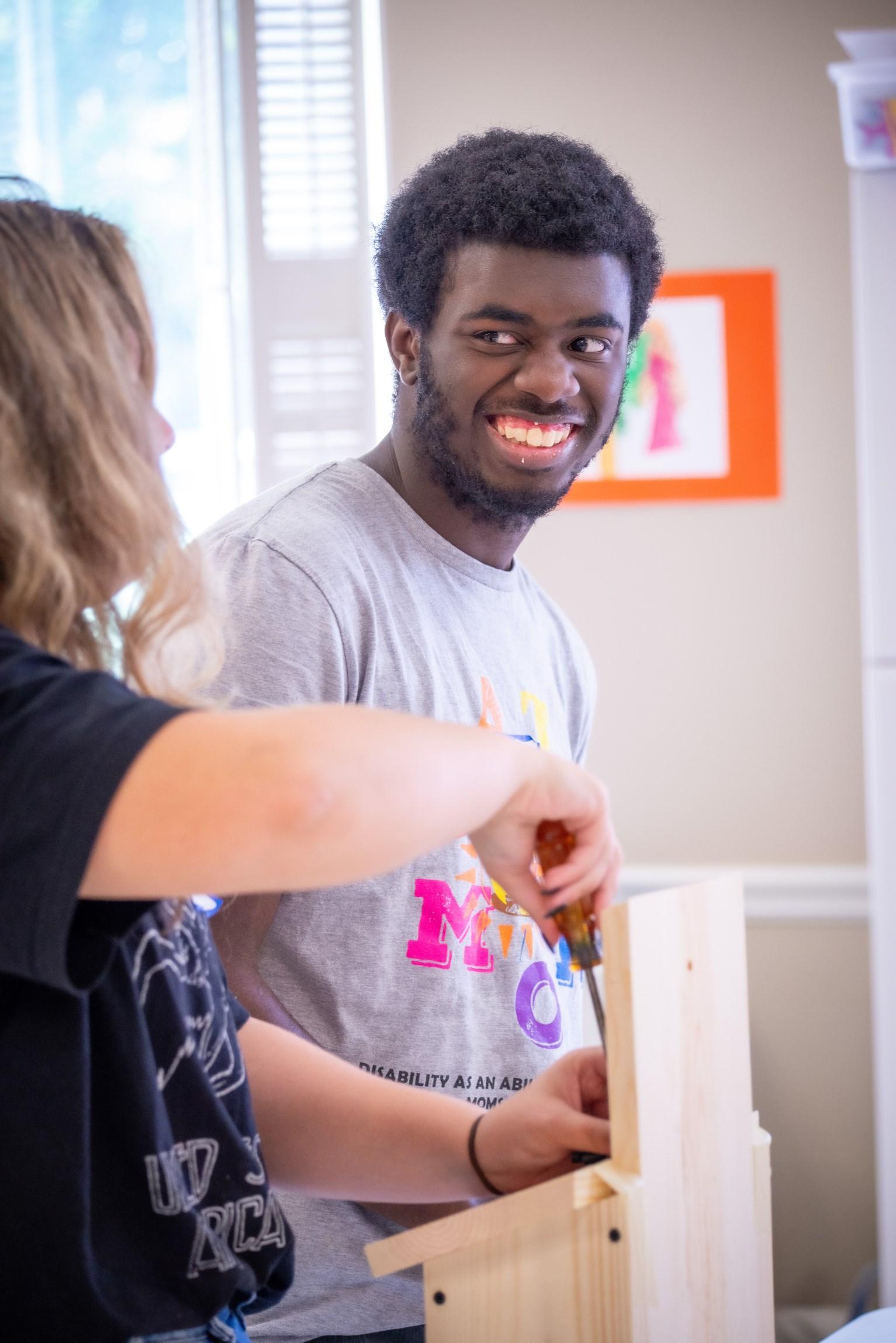
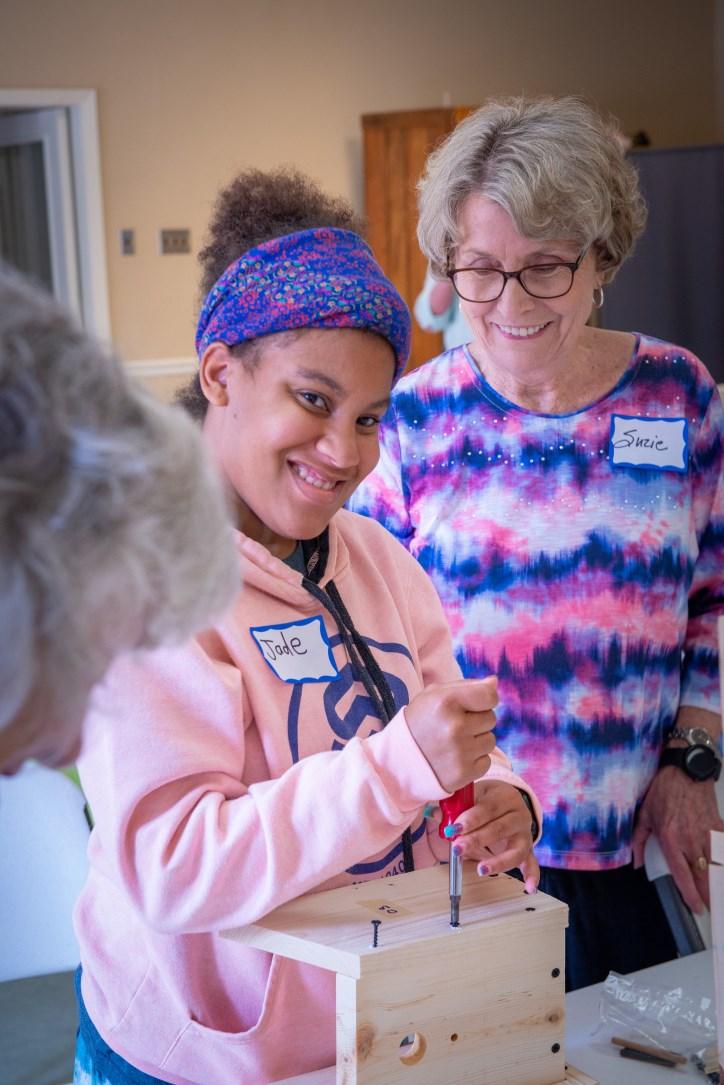
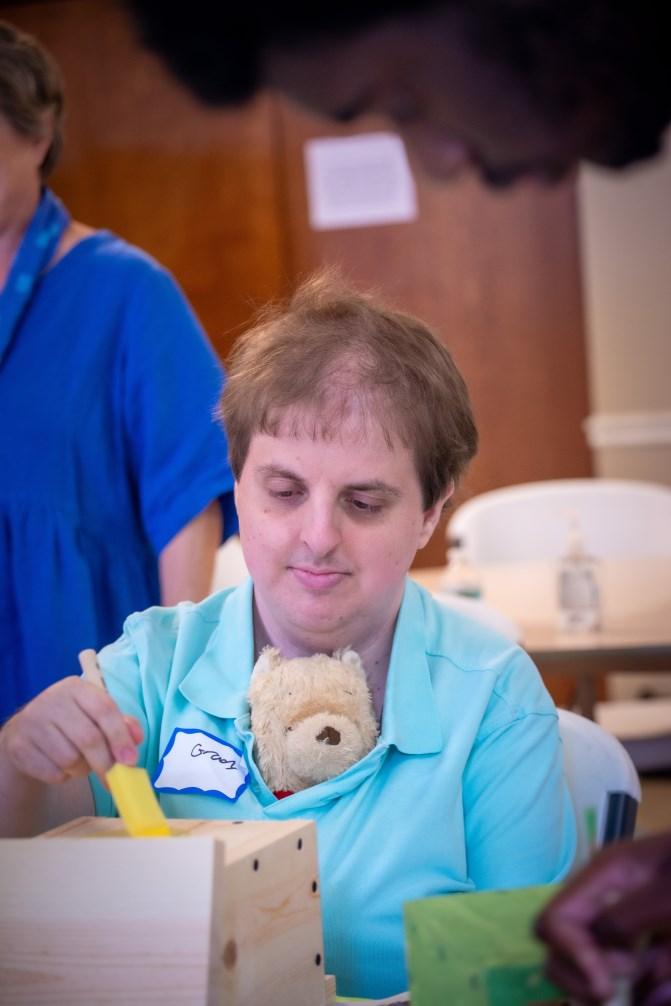
Proceeds from the show were divided among the five artists, and each of them earned $120. They were ecstatic!

8 THE EPISCOPALIAN
By The Rev.
It’s hard to talk about. It’s even harder to live through. Many parishes like Church of the Holy Comforter, Montgomery, were once large, thriving communities of faith, and now have experienced years of decline. The painful questions about sustainability can no longer be ignored. The answers aren’t easy and we are still finding our way. Our story is not yet fully written. However, even now, we can see and touch and feel how the words from the prophet Isaiah are true and thrilling.
I came to serve at Holy Comforter at the end of 2018. The following year was busy there was much to learn. Together, the parish and I had some housekeeping and decluttering to tackle in many aspects of our common life. Towards the end of 2019, we also began a simple process of discernment, an exploration of what God might be calling us to do and be, moving forward. We had gained some discernment traction, and then the pandemic shut us down. By happenstance, we had been invited to participate in an interdenominational program that helps congregations experience renewal and redevelopment by starting a social enterprise that meets the needs of the surrounding community. Our discernment process morphed into participation in this program. We learned a lot, and we worked with some lovely people. However, it became clear, by the end of 2021, that the Oikos program did not fit or meet our needs. Another dead end. The sense that the clock was still ticking


9
“Behold, I will do a new thing”
Continued on the next page.
Rosa Lindahl
though, were desolating. And then, one of the last people to speak said something completely different. “I do not believe that this is a faithful response to where we find ourselves. We have an incredible facility, all kinds of resources, including financial, that many other churches don't, and a legacy of making a difference in Montgomery. Whether Holy Comforter lives or dies, I want us to figure out how to ensure that this place and our resources continue to be a source of blessing in this corner of the city.” It was like a bolt of lightning. That day, a new clarity and sense purpose took hold and has only grown.
In the following months, we identified several ministry programs that would benefit our city. We researched the options and settled on one. There are precious few programs for adults who cannot function independently because of intellectual or neurosensory divergencies. A program in Maine caught our attention. Spindleworks is an arts-based day program. Accomplished artists from the area work with the men and women who need this day support and who are called “artists in residence.” Along with
This is the most hopeful avenue we have found to be faithful to God and our community, and to stabilize our financial situation. We marvel at the possibility that our large facilities that sat unused for years will team with life as the program grows. Will it bring new people to our church rolls? It's hard to tell, because we will need to be careful to comply with Funding Agency requirements regarding evangelism and proselytizing. In a sense, we have to carry that hope lightly. There has to be room for God's gracious Providence to do its work. But we can say categorically that in our work, we are discovering what it means to trust in the words of Isaiah. [God has said], behold, I will do a new thing.
Rosa Lindahl Rector, Church of the Holy Comforter,
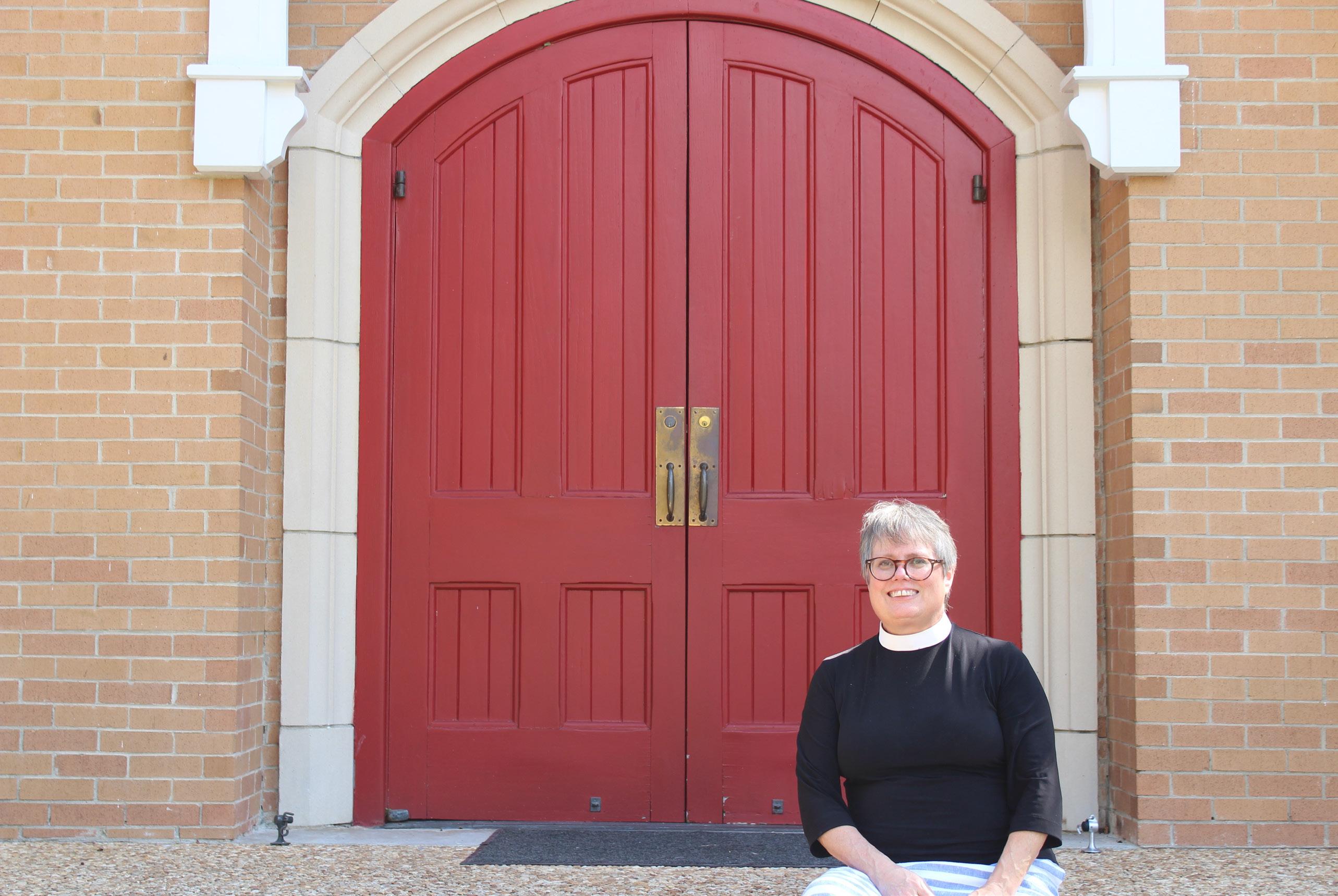



In addition to the Many Colors Art Collective, Holy Comforter hosts a weekly food pantry. Partnering with nearby Immanuel Presbyterian Church, the food pantry is open from 10:00am - noon each Tuesday, and supplies critical nutrition to hungry individuals and families in the Montgomery area.
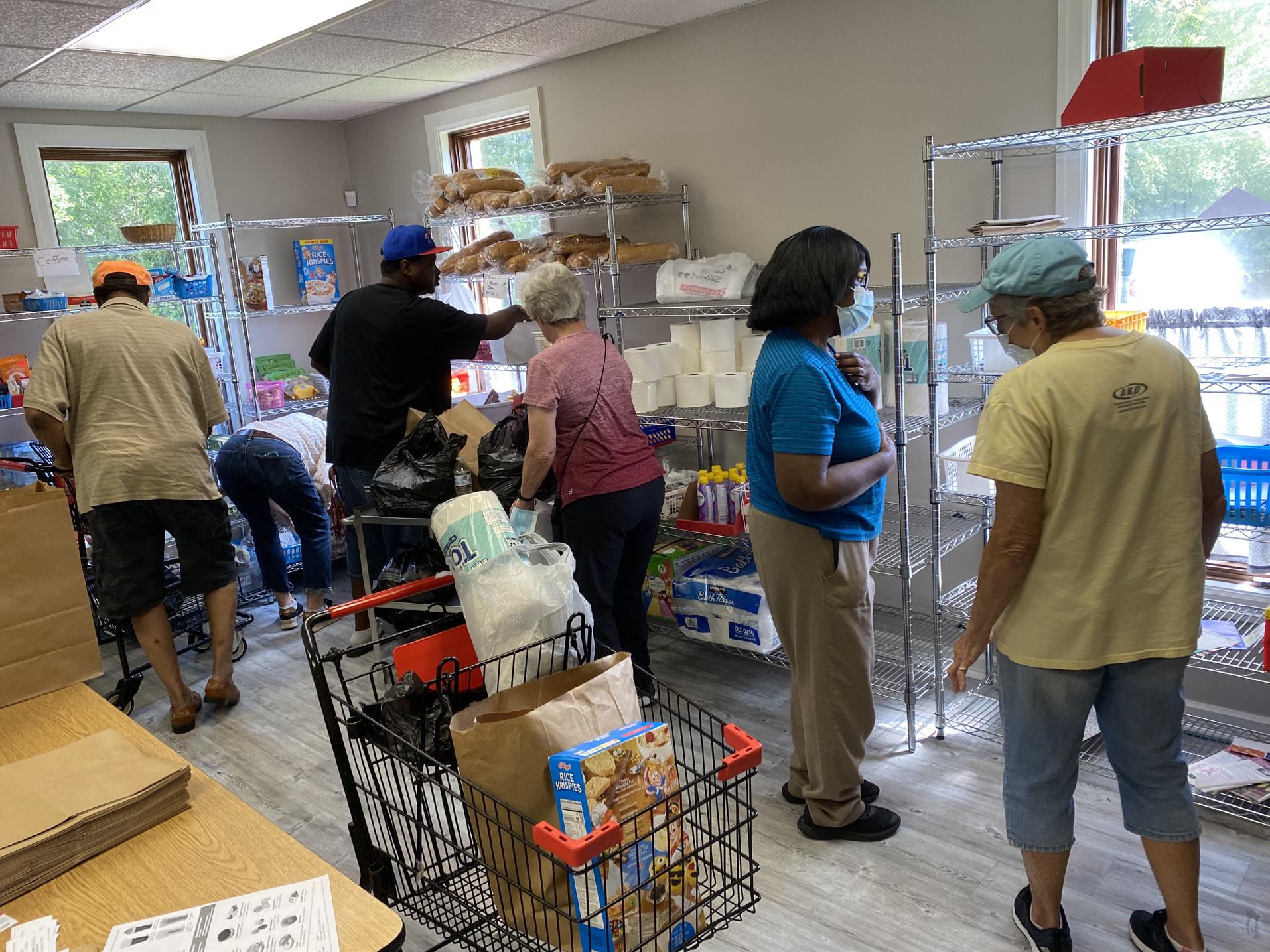
If you would like to learn more about this ministry, please contact the church office, (334) 281-1337.
 Article photography by Hugh Hunter Photography Learn more about the Many Color Arts Collective by scanning this QR code.
Article photography by Hugh Hunter Photography Learn more about the Many Color Arts Collective by scanning this QR code.
10


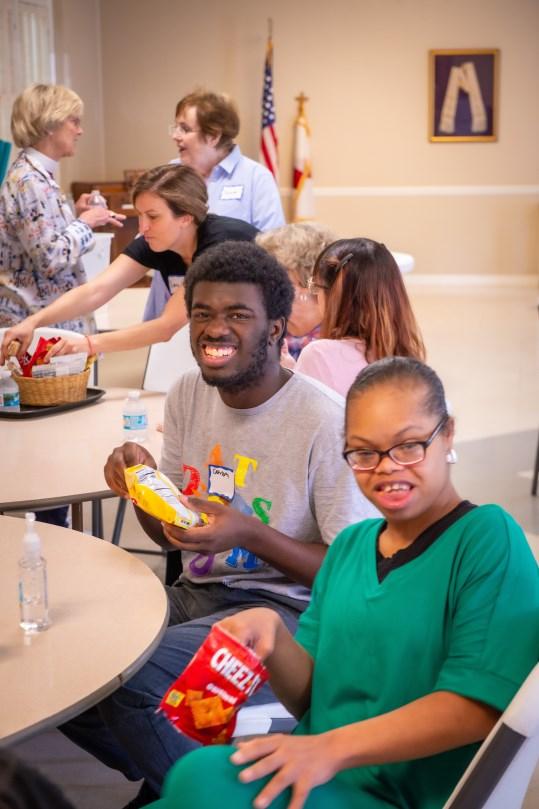
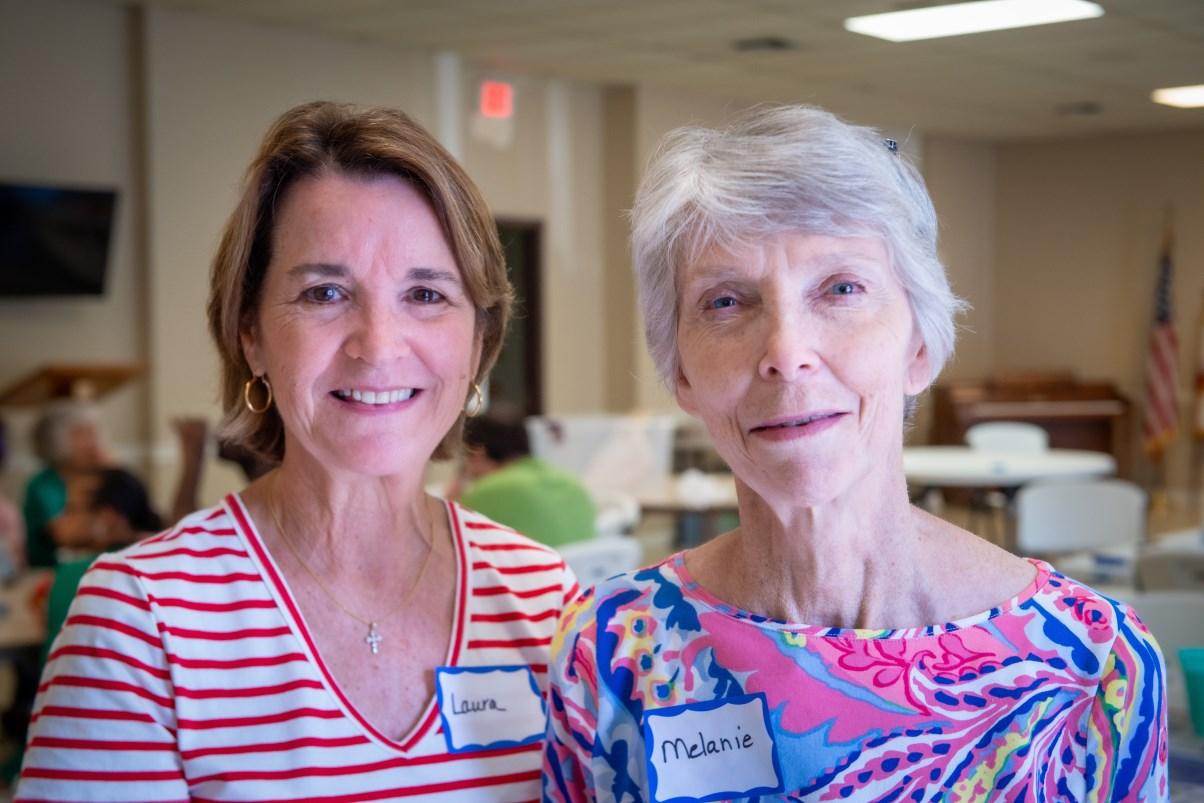
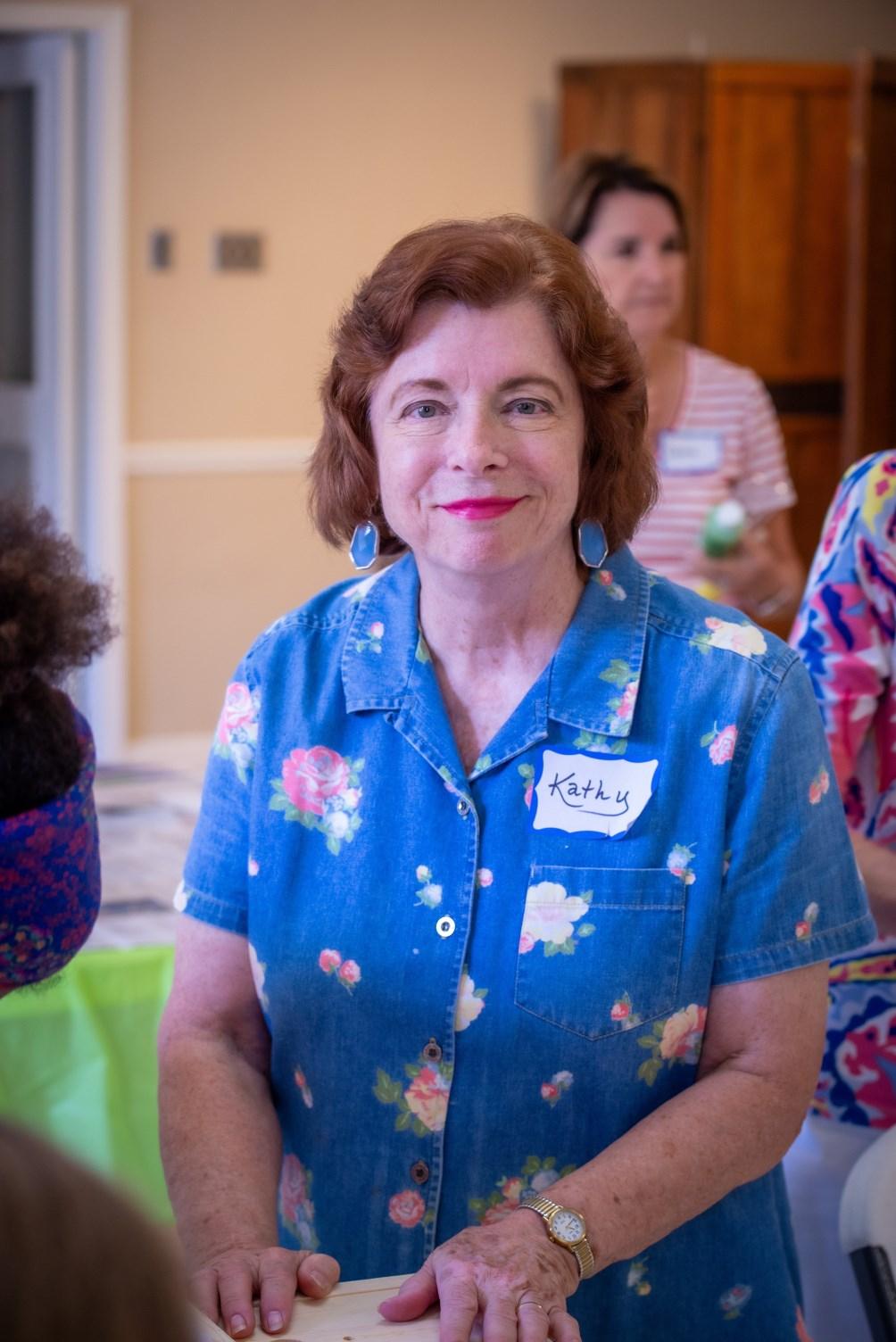


11
The Rev. Rosa Lindahl, Rector at Holy Comforter; Laura Brendle, left, works alongside the artists and is on the board of Many Colors, and Melanie Hayes, right, serves as Program Lead; The artists enjoying a snack break; Kathy Albree, Lead Artist Mentor of the program
If you happen to be driving in downtown Huntsville on a Thursday morning during the months of May to October, you ’ll spot a group of men and women hauling out folding tables and pop-up tents into the Church of the Nativity parking lot. By 2:00pm, a line of pickup trucks of all makes and models idle on the corner of Greene Street and Eustis Avenue, waiting their turn to back into one of the 55 slots. Church volunteers work behind truck beds full of fruits, vegetables, baked goods, jams, and fresh cut flowers, unloading gifts of the earth. By 3:00pm extension cords
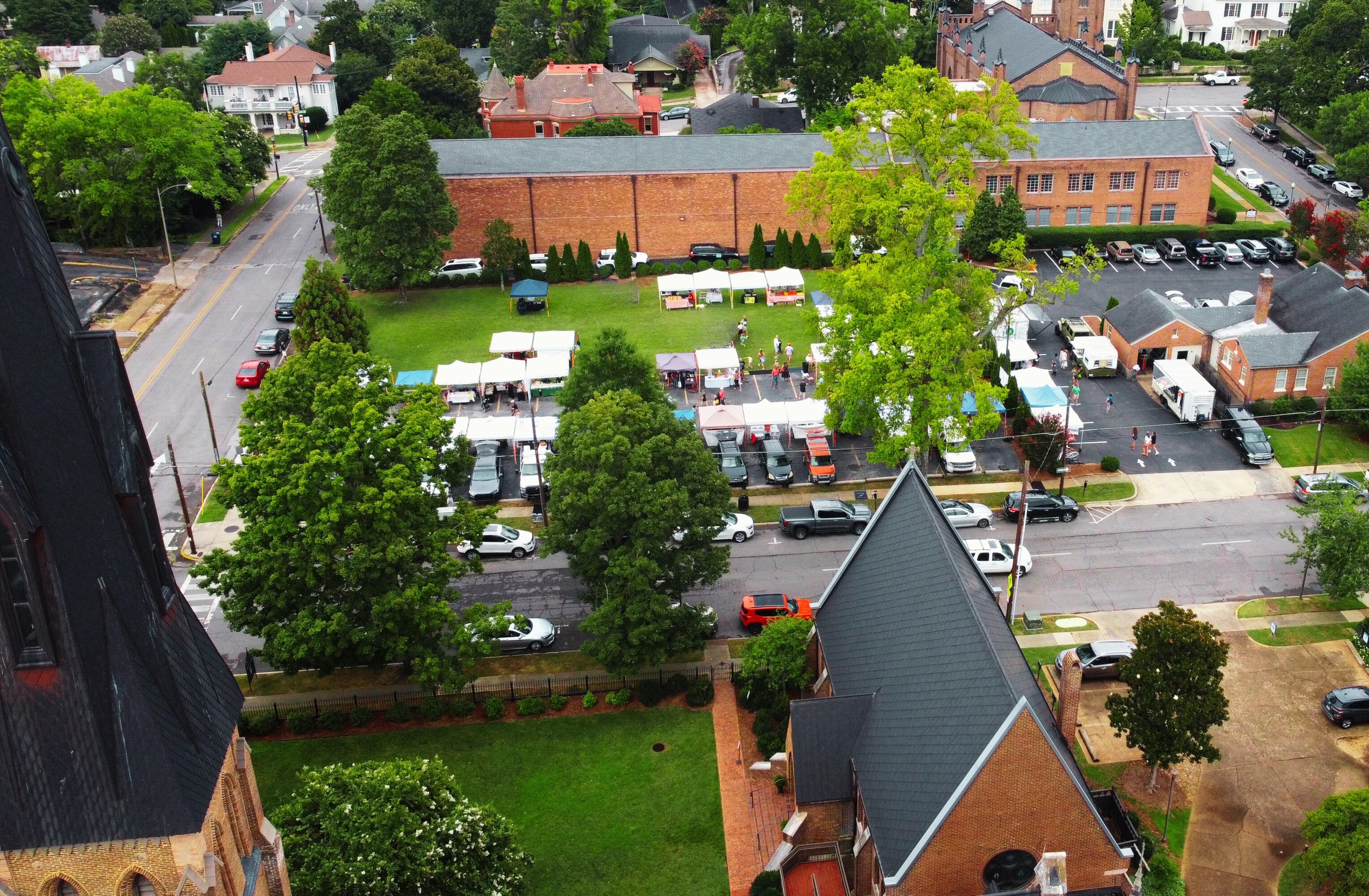
power up deep freezers packed with farm-raised chicken, steak and pork. It’s getting hot, but there is so much to see, and before you know it, there is a lightness in your step, and the fiddle player in the band plucks out a melody from a time when the farm was the center of everything.
And that is what Greene Street Market is all about. Setting the table for the everyday Eucharist. It’s a place for everybody to come to the table, but it’s a table set in the parking lot of the Church of the Nativity, Huntsville. Marilyn Evans, co-founder of the market states, “It’s a place - that over the years - is welcoming to everybody.” Its mission is not only to ‘provide Huntsville’s community with local, fresh, nutritious high-quality produce’ but also to ‘enhance the quality of life in the Madison County area’ by providing a space for community engagement. Evans shares story after story of how the market has been a space set for people who would not normally come to church but feel ‘church’ community when they are at Greene Street Market. She recounts one memory in which a local farmer shared “that his life was a mess”. His daughter was struggling with an illness and TVA was threatening to reclaim his farmland. “He asked me if there was someone from the church that could come talk to him,” shares Evans. Her response was YES, we can do that! She didn’t know what the priest and the farmer talked about but the very next market the farmer said that he looked up the Book of Common Prayer online and ‘had spent some time with it’. “He said to me, you knowwhere I come from people like me don’t join the Episcopal Church, you have to be invited,” remembers Evans. Evans got him a prayer book off the pew rack. Not long after the farmer shared that through those prayers he found the guidance he was searching for.
In 2011, seven vendors showed up for the very first market ‘and it was good.’ Like the sacred story, the herb and the tree continue to yield seed and fruit in due season. Today the market provides spaces for over 350 vendors to sell during the growing season. Continued on the next page.
12 THE EPISCOPALIAN


DIOALA.ORG 13
my of buying locally.” “Here we are in a state that has a long growing season and very fertile ground, and yet 98% of Alabama’s produce is shipped in from over 2000 miles away.” Greene Street Market provides ‘market bucks’ and accepts EBT/Snap benefits with a 2/1 ratio. Through a grant from Auburn University, every dollar spent though EBT/Snap is doubled for fruits and vegetables. Even after the grant ended the program remained with the market subsidizing the funds.
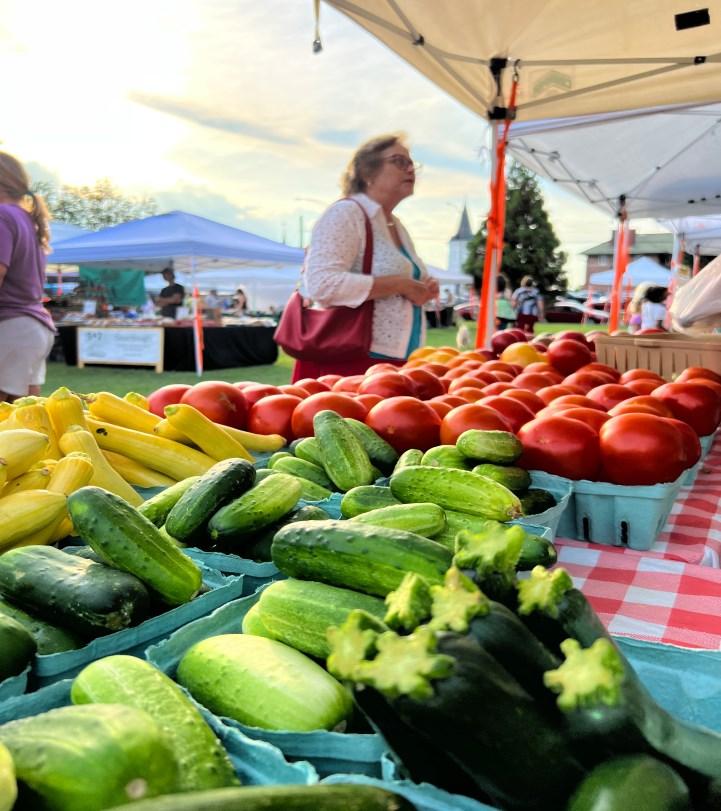
For 12 years, Greene Street Market has continued Nativity’s commitment to the Stewardship of Creation, hospitality, mission and outreach while providing funds for programs to make a difference for good in the community. “Every year, somehow, we still earn the same amount enabling us to give somewhere between $20,000-25,000 to Nativity’s outreach budget,” states Evans. From gifting the Boy and Girls Club to buying a dental chair for the Community Free Dental Clinic, Nativity’s outreach committee finds a community need and makes a difference.
So, next time you’re in town, skip the grocery on Thursday evening. Take a seat next to toe tappers drinking iced tea while listening to the band. Stand next to folks with market bucks, credit cards and cash. And enjoy watching young parents pushing empty strollers while escaped children jump in line next to the elderly for popsicles. Chat with your local farmer, pet a goat. It’s growing season in Alabama, and at Greene Street Market no invitation is necessary - come as you are.
-Kana Goldsmith

Article photography by Steven Jackson
Learn more about the Green Street Market by

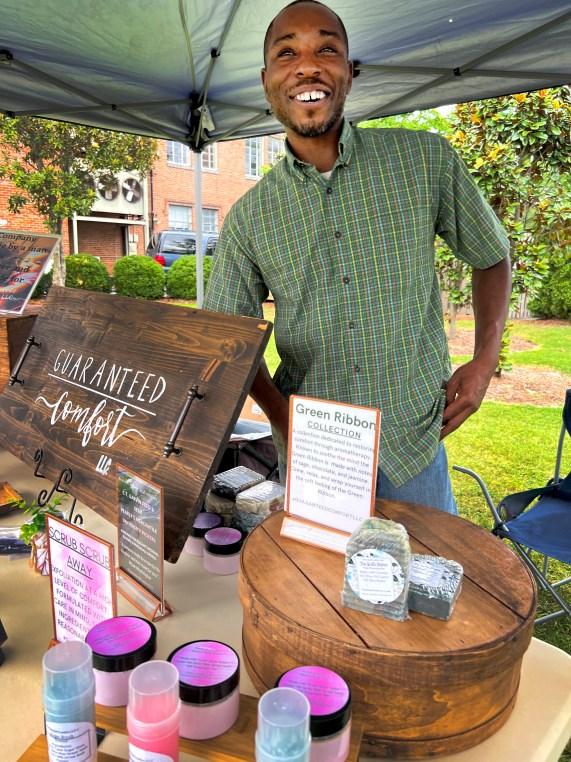
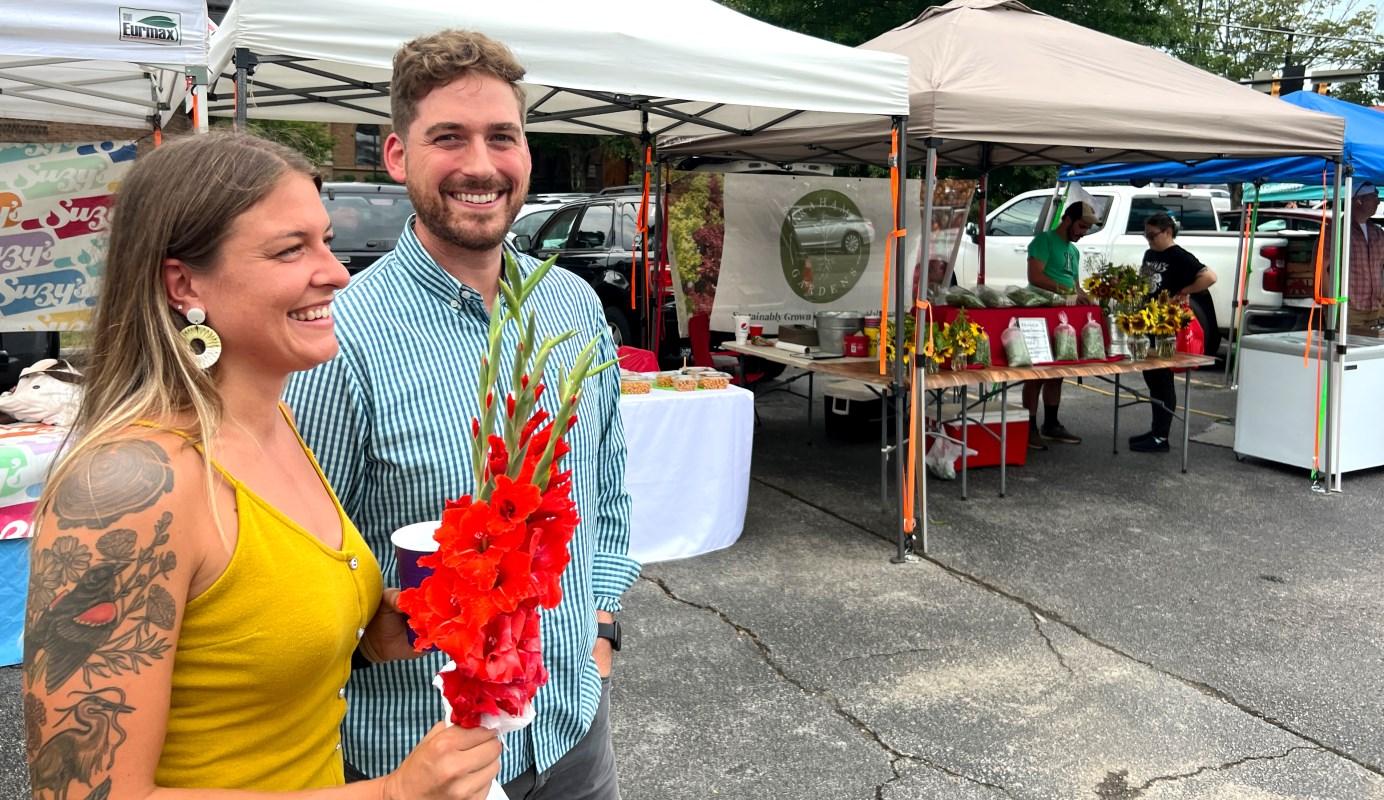
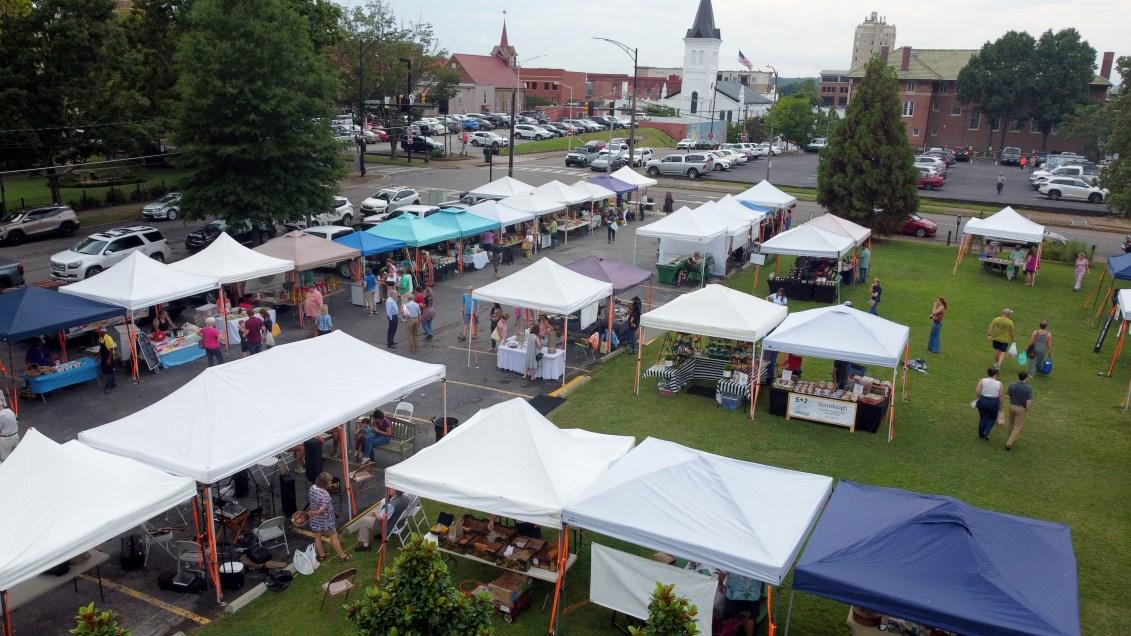
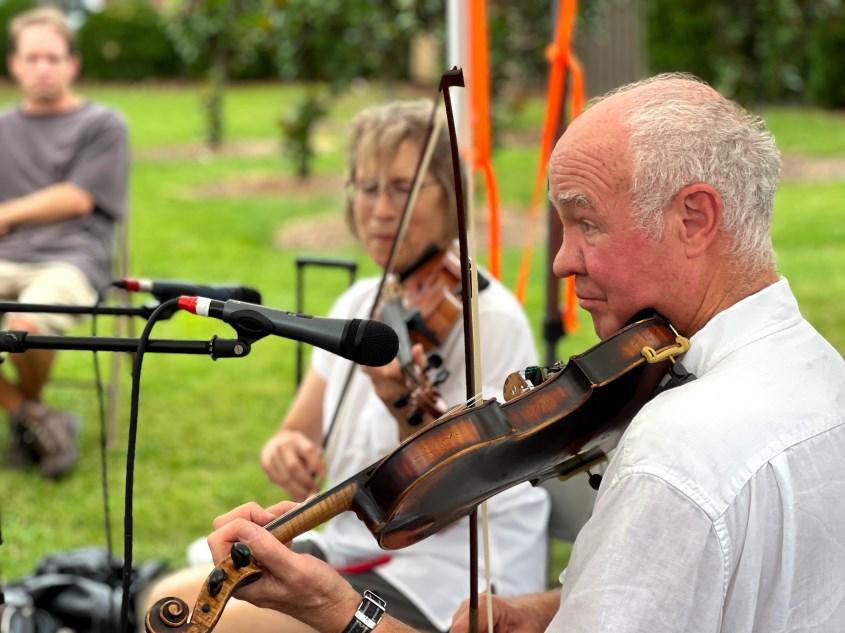
Some of you may remember that The Abbey started as an Episcopal church and coffee shop in the Avondale neighborhood of Birmingham. The vision was to create welcoming space for the growing number of people who were distanced from institutional, Sunday morning-driven church –regardless of the reasons. Our worshiping community, staff and volunteers served many thousands of cups of coffee, cookies and sandwiches - often regardless of a guest’s ability to pay. We prided ourselves on our “Radical Hospitality, Authentic Diversity” motto.
In 2019, things began to change. Diocesan funding came to an end, and we closed our coffee shop ministry. Just as we had begun to re-envision how to offer hospitality and Good News to our neighbors, the pandemic hit. In 2021 we came back together, in the comfortable basement of a local school, but in 2022, the school building was sold and we found ourselves churchless yet again, in the midst of a rent and real estate boom.
Though discouraged, our community turned to scripture for guidance. We meditated on the story in Luke 22, where Jesus sends two disciples into Jerusalem to find a place for the Passover dinner. He instructs them to ask the house owner, “Where is your guest room?” Personally, I imagine that the disciples’ next words were probably something like, “so and would it be okay if we use it? Tonight?”
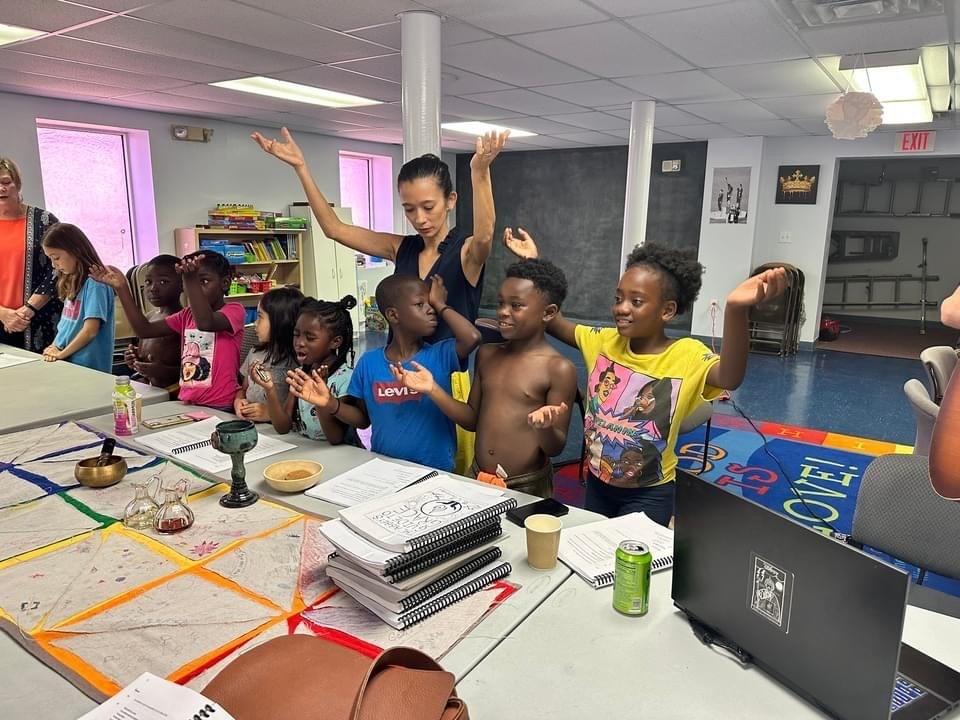
14
The Spirit led us to accept an invitation from Zion Spring Baptist Church to use their sacred space on Sunday afternoons. Though less than a quarter mile from our original coffee shop location, Zion Spring is on the “other side of the tracks.” The red brick church is located in the middle of a 1970s era public housing project that is 95% Black. While the church property is well kept, the neighborhood is littered with trash, fire ant beds and empty bullet casings.
At first, Abbey folks were apprehensive about introducing ourselves in the neighborhood, and most of us felt conspicuously out of place. We also wondered, is it even possible to engage our neighbors without inadvertently adopting a “white savior” posture, or coming across as clueless proselytizers? Finally, we developed a “script” that stated nothing less than the exact truth: “Hey - we wanted to meet you and say thank you. We’re a group of Episcopalians who don’t have a church building, and Zion Spring took us in. We are so grateful for the hospitality of this neighborhood and we hope, someday, to bless you back, however we can.”

Now, once a month, folks from Zion Spring and The Abbey gather together for several hours of shared conversation and food. We talk about the many things our churches have in common, and we also talk about our differences.
The blessing that continues to come to The Abbey - from the coffee shop years to this new life together with Zion Spring - is that we are forced to ask ourselves, every single day, “and who is my neighbor? ” My neighbor is the one who helped me. The one who took me in when I was a stranger. My neighbor is the one in whose house I am a guest, even when we’re of different colors or different cultures.
Eventually, The Abbey will discern a way to give back to the church and the neighborhood that said “Yes, you can use our room to remember the Lord’s Supper.” But, until then, we will focus on the blessing of being hosted.

Learn more about The Abbey by scanning the QR code.
15
 The Rev. Katie Nakamura
Caption
Celebrating the Eucharist at The Abbey, in the fellowship hall of Zion Spring Baptist Church.
The Rev. Katie Nakamura
Caption
Celebrating the Eucharist at The Abbey, in the fellowship hall of Zion Spring Baptist Church.


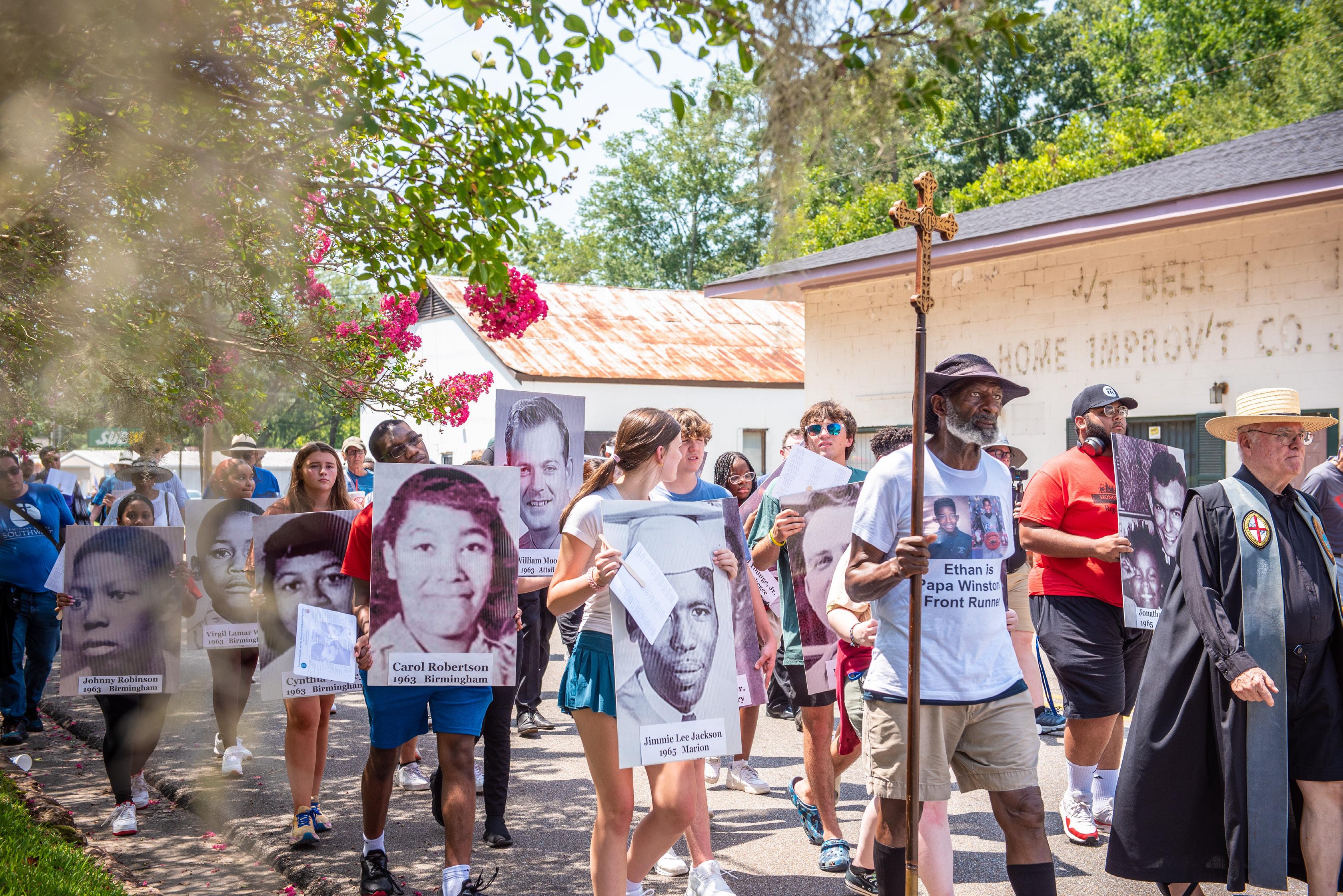
16 THE EPISCOPALIAN
Led by Verger Don King, pilgrims make their way from the jail to the Courthouse square,
It was the beginning of the last six days of Jonathan Daniels’ life, most of which would be spent in a squalid county jail and which would end with the 26-year-old dying from a shotgun blast as he saved the life of another. He would become the 26th civil rights worker to be murdered.

Early that Saturday morning, 30 people most of them young, most of them African-American and most of them from the area gathered at the AME church just outside of town to finalize their plan to protest outside of businesses in Fort Deposit. They wanted to call attention to discriminatory hiring practices, unequal treatment of customers and price gouging.
Many had been involved in an unsuccessful boycott earlier in the year of their segregated black high school after its superintendent refused to consider a list of demands aimed at improving their education. And the county school board blocked their attempt to integrate the all-white high school in Hayneville about 18 miles away. They wanted to find a niche in the civil right movement in Lowndes County, often called “Bloody Lowndes” for the way violence enforced segregation.
Just eight days earlier, President Lyndon Johnson had signed the historic Voting Rights Act. Most of the young organizers who gathered on Aug. 14 were too young to vote, but they wanted to be part of the movement, so they proposed the protest against businesses in Fort Deposit. They soon learned that two FBI agents were in town to observe the first voter registration efforts in the county. The agents, one author says, told them police were prepared to arrest the protestors as soon as they entered the street. At the same time a crowd of white men armed with clubs, broken bottles and guns was assembling to confront them.
The protest lasted a few minutes until police arrested everyone, including Jonathan Daniels, a white seminarian from what then was known as Episcopal Theological School, now Episcopal Divinity School, in Cambridge, Massachusetts. They were loaded onto a flatbed truck the county normally used for hauling trash and taken to the jail in Hayneville, the county seat of Lowndes County.
Continued on the next page. 17


In Fort Deposit, Alabama, the day of August 14, 1965, began hot and humid, and it only got more oppressive as it went on.
At the Hayneville Jail after their arrest, the group spent six hot August days in the jail without air conditioning. There were no showers and no toilets. Daniels led the group in hymn singing and prayers, boosting morale and combating the bleakness of the situation.
Two of the prisoners made bail on their charges and left for Selma on Aug. 20. A few hours later, the jailers inexplicably unlocked all the doors and told the rest of the prisoners they were free to go.
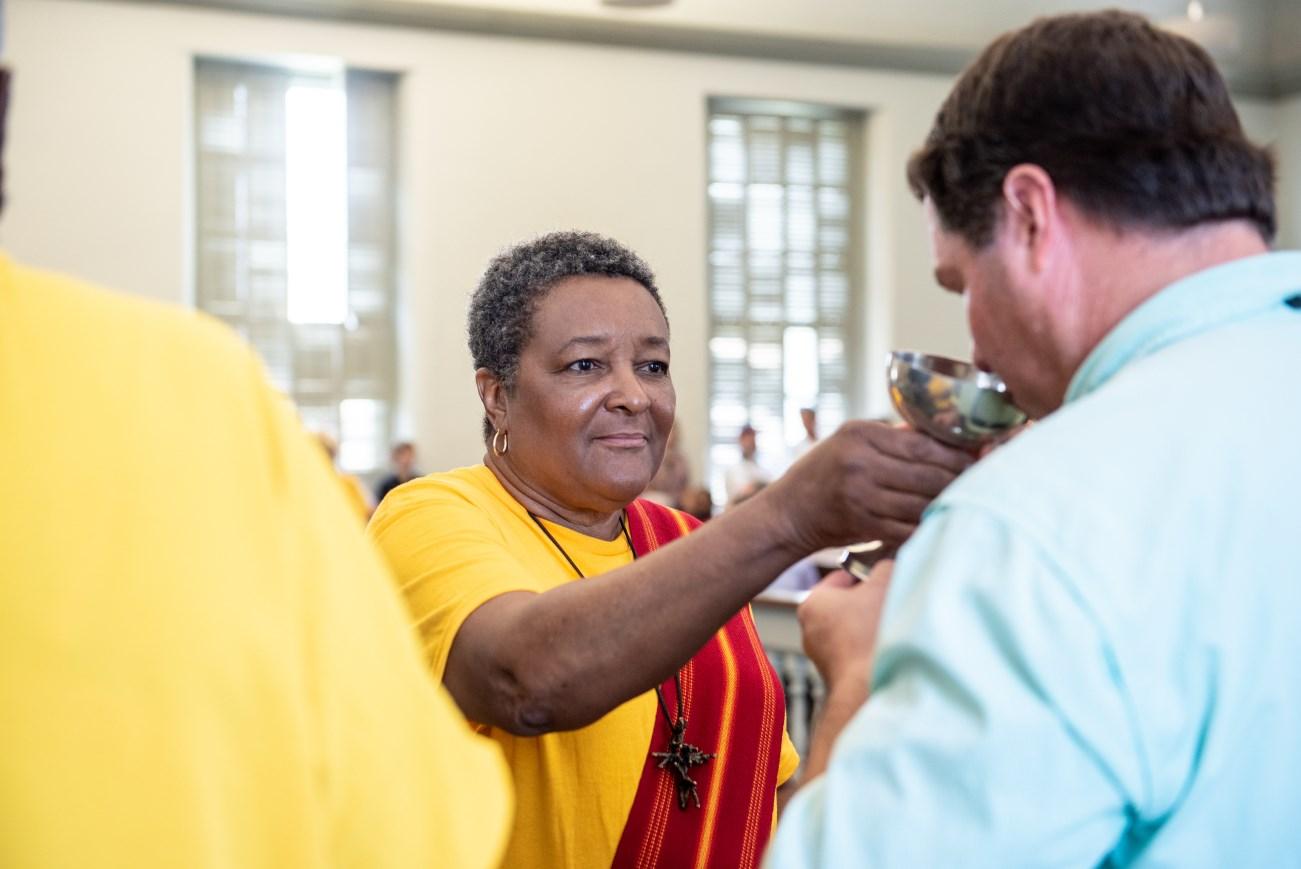
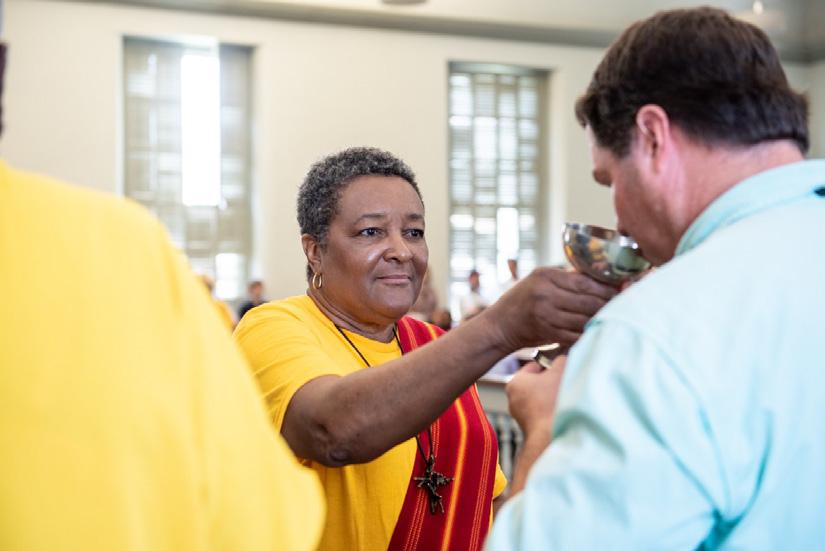
While waiting for a ride and after having been ordered off the jail property, Daniels, Catholic priest Richard Morrisroe and two black demonstrators, Joyce Bailey and Ruby Sales, walked to buy soda for the group at Varner’s Store, about 50 yards from the jail.
Thomas Coleman, a county special deputy wielding a 12-gauge automatic pump shotgun, stood on the concrete pad outside the store. He crudely ordered them off the property.
“Things happened so fast,” Ruby Sales, who was 17 at the time and on leave from Tuskegee Institute, recalled years later. “The next thing I know there was a pull and I fall back. And there was a shotgun blast. And another shotgun blast. I heard Father Morrisroe, moaning for water.” “I thought to myself: ‘I’m dead. This is what it feels like to be dead.”
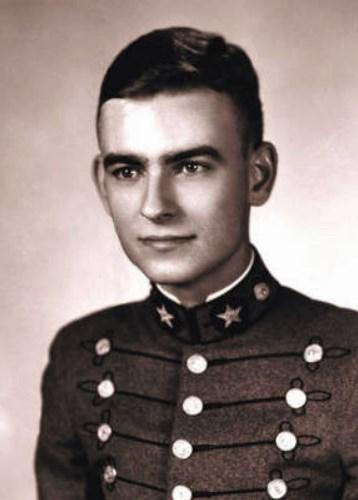
Bailey, who had run behind an abandoned car, called to Sales who, realizing she was still alive, crawled over to her. They began to run. The rest of the group scattered and ran, knocking on doors as they passed homes. “Nobody would let us in; people were so terrified,” Sales said.


Coleman, a county engineer and member of one of the oldest white families in Lowndes County, had leveled his gun and fired, blowing Daniels backwards. Daniels lay motionless on the ground and was dead. He was 26 years old.
This article is excerpted from a story by Mary Frances Schjonberg written for the Episcopal News Service
Article photography by Andi Rice Mediaworks
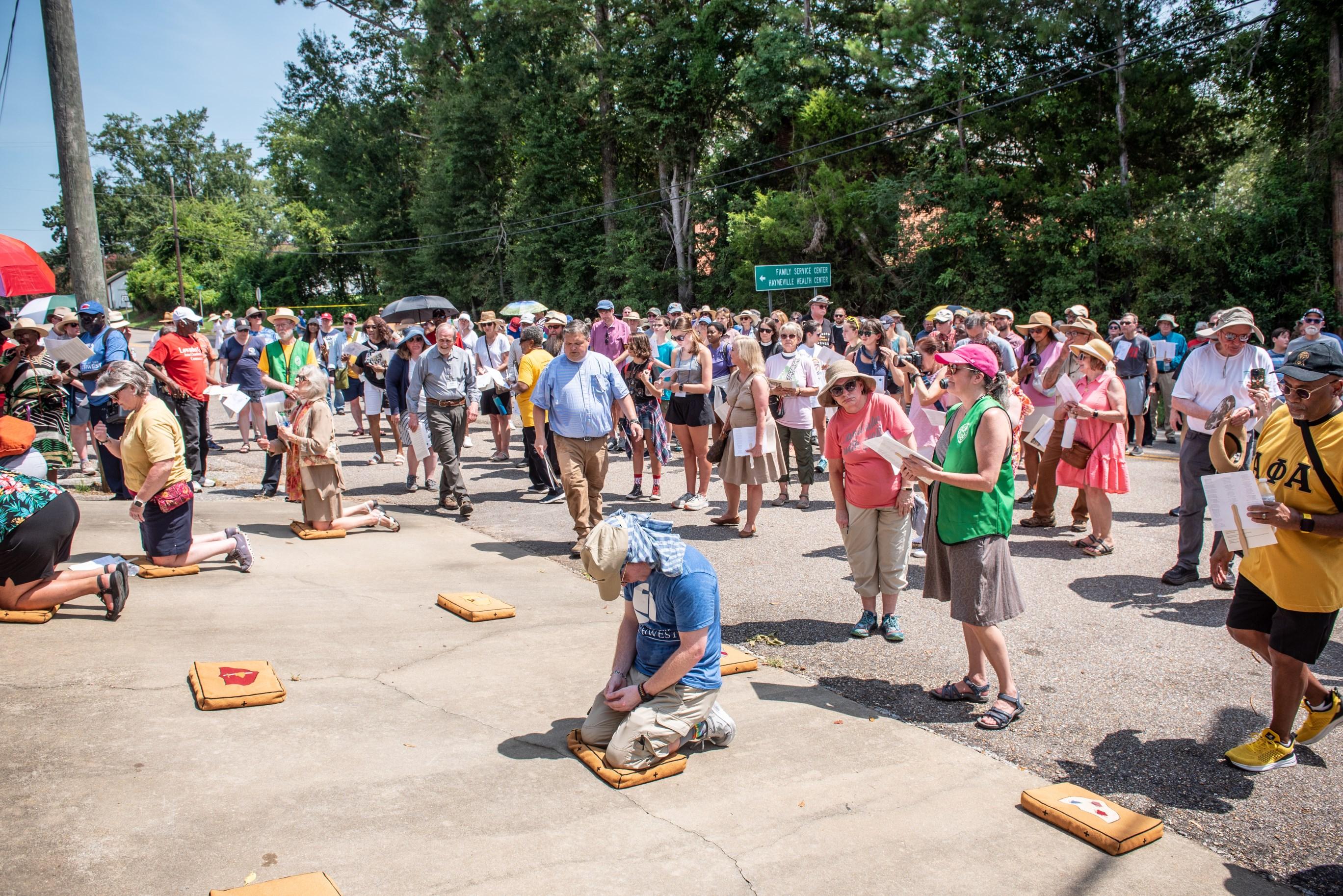
At right: Youth from the Diocese of Alabama and from New York holding photographs of the Alabama martyrs. The Rev.
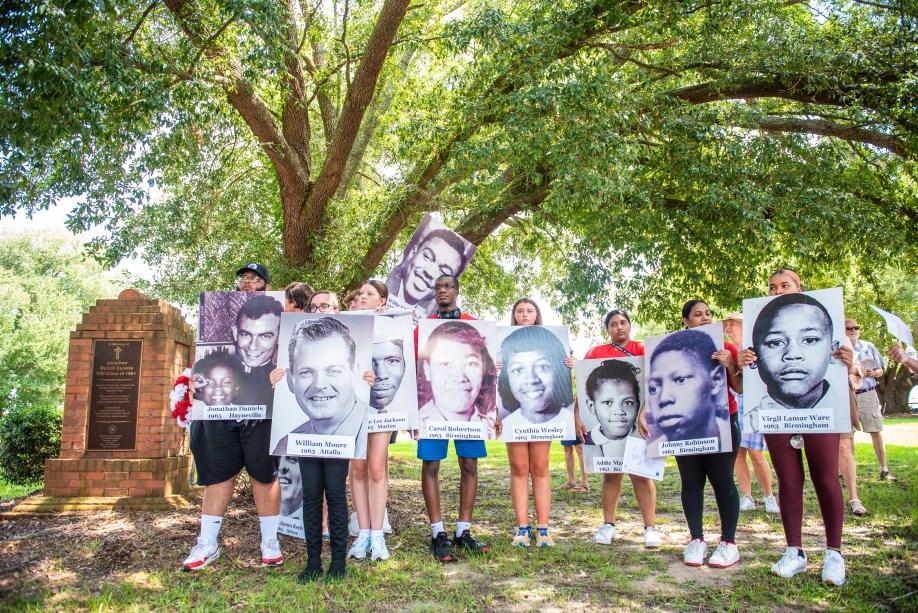 Carolyn Foster serving the chalice during communion.
At left: Jonathan Daniels while attending Virginia Military Institute.
Below: Pilgrims pause in front of the site where Jonathan was killed.
Carolyn Foster serving the chalice during communion.
At left: Jonathan Daniels while attending Virginia Military Institute.
Below: Pilgrims pause in front of the site where Jonathan was killed.
18 THE EPISCOPALIAN
On August 12, 2023, people from across the country gathered in the courthouse square to remember the life of Jonathan Daniels and the Civil Rights martyrs of Alabama. Pilgrims this year included people from all walks of life, an Episcopal youth group from New York, students from Seminary of the Southwest in Texas, and representatives from the schools Jonathan attended, Virginia Military Institute and Episcopal Divinity School.

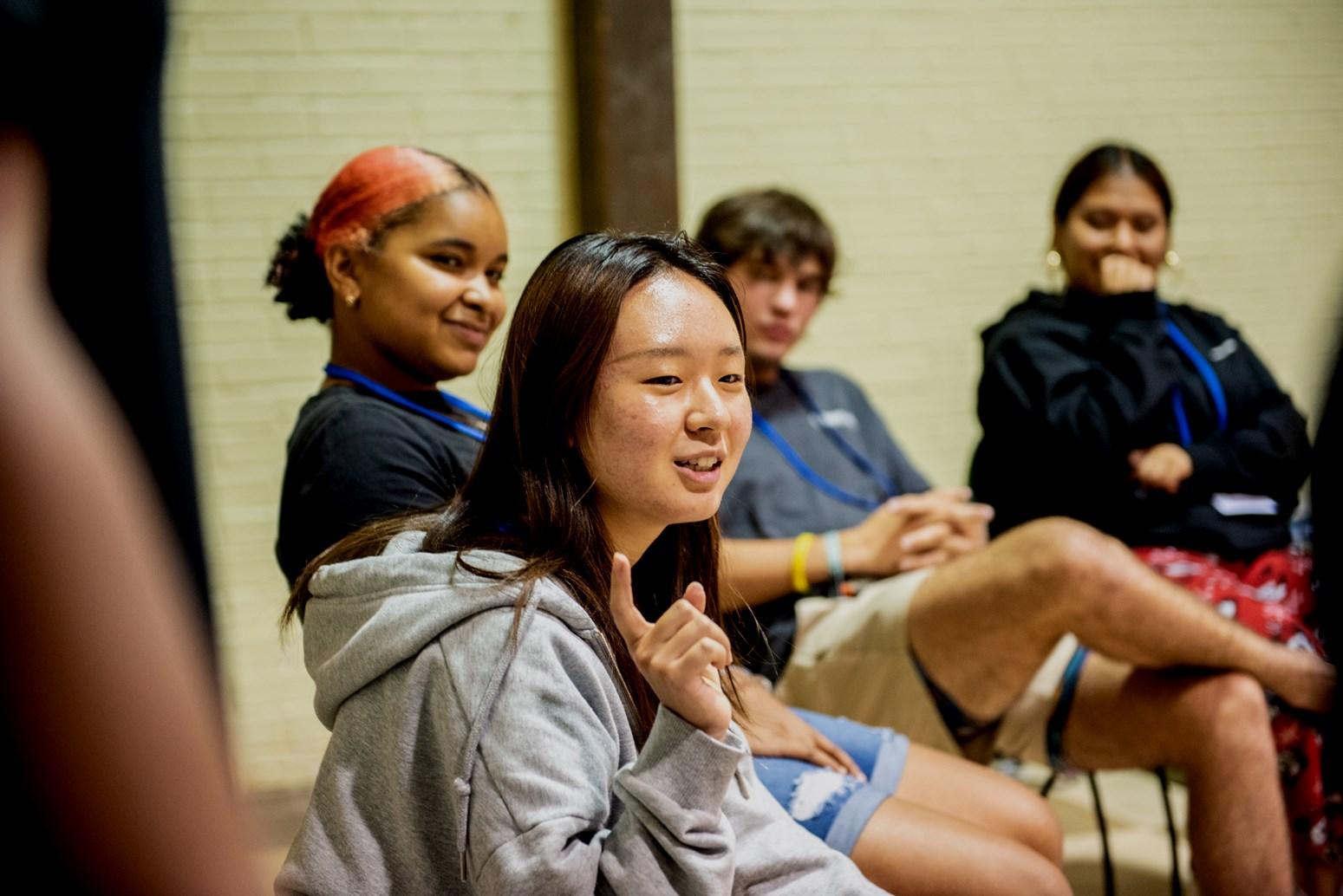

Youth from the diocese of Alabama and New York participated in a pilgrimage retreat the night before at the Church of the Ascension, Montgomery, and assisted the pilgrimage by carrying large photographs of the fifteen martyrs. After opening prayers in the square, the procession moved to the old county jail where Daniels was detained, singing hymns and spirituals as they walked. The procession then moved to the site of the old Cash Grocery Store where Daniels was killed, and pilgrims kneeled in prayer. The pilgrimage ended at the Courthouse, where a service of Holy Eucharist was celebrated in the same courtroom where the man who shot Daniels was tried and acquitted by an all-white jury of men.

Following the pilgrimage, participants went inside the courthouse to listen to a conversation about race between Bishop Curry and The Rt. Rev. Phoebe Roaf, Bishop of West Tennessee, which was followed by the service of Holy Eucharist. Fourteen other martyrs of the Alabama civil rights movement were also recognized and honored, and as each martyr’s name was read, a gong was rung, and a candle was lit in their memory. A young person came and stood at the front of the room holding a photograph of each martyr, and this continued until all fifteen martyrs’ names had been called. A choir, with members from the Diocese of Alabama and the Diocese of the Central Gulf Coast, led the singing at the service. The Rt. Rev. Russell Kendrick, Bishop of the Diocese of the Central Gulf Coast was the celebrant. The Episcopal Church added Daniels to its Lesser Feasts and Fasts calendar of commemorations in 1994. His feast day is Aug. 14, the day of his arrest. Daniels was added to the Episcopal Church Calendar of Saints and Martyrs in 1994, and the annual pilgrimage is usually held on

DIOALA.ORG 19
Youth gathered at Ascension, Montgomery, for a youth pilgrimage retreat on Friday night.
Following the pilgrimage, Bishop Curry and Bishop Roaf began a conversation in the courtroom about experience with race in their own lives, and the meaning of the word “racism” to each of them. Bishop Curry talked about what she saw of racism as a child living on a military base. “We were told that in the military everyone saw skin color the same, that there was no difference. I had a best friend named Jackie, who lived across the street from me. Jackie was Black. I loved her dearly, and her family. We all did things together and then one day I came in and said, hey, Mom, Jackie and I want to go to the movies, and she said, you can’t do that. And that’s when the whole world shifted. And I knew that I was forever changed in that moment. It was an epiphany.”
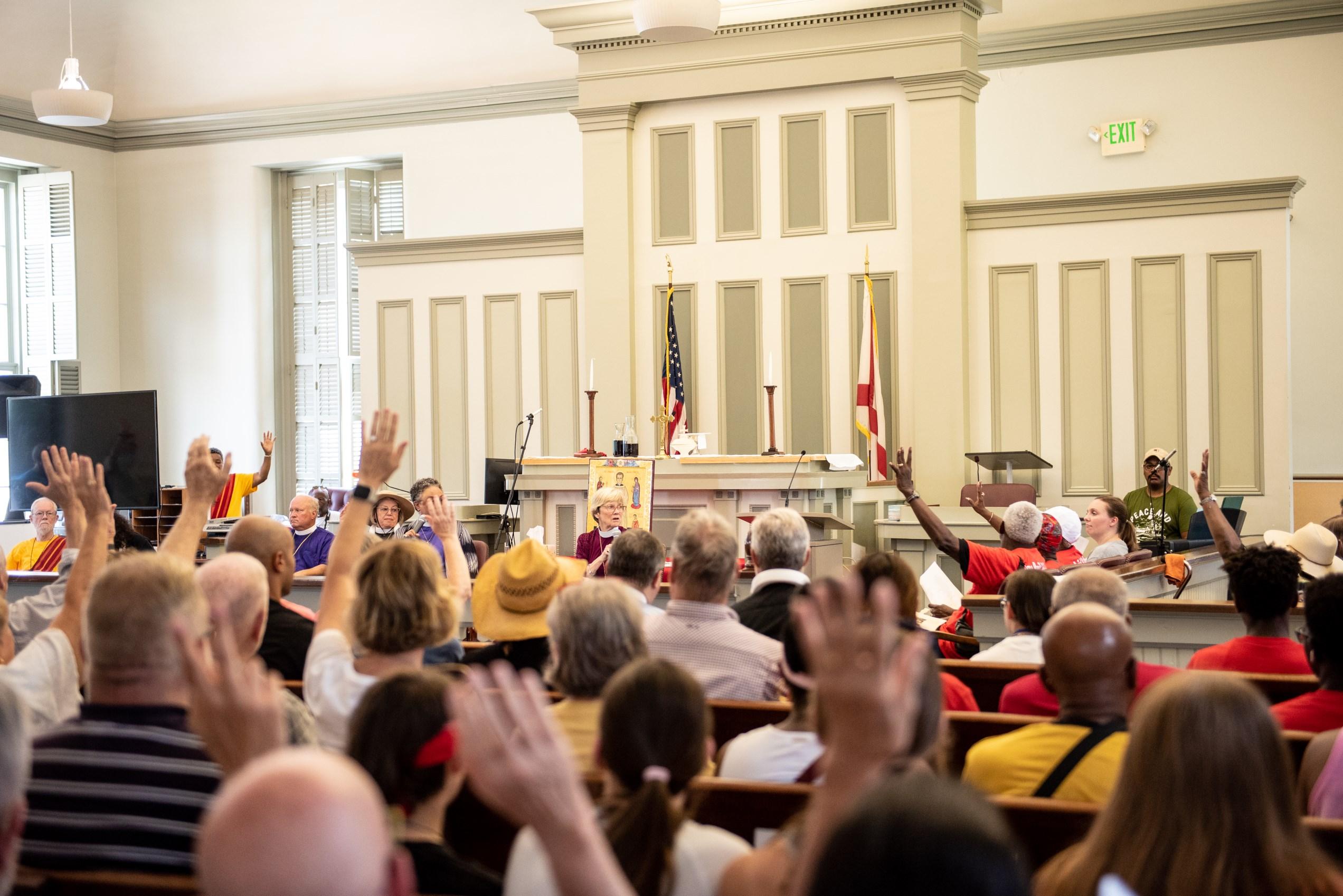
Bishop Roaf also began by talking about her life as a child, and what it was like being in first grade just as schools became integrated. “I'm now 59, so everybody who is older than me and who went through public education had a portion, some, or all of their experience in a segregated system. In a sense, brothers and sisters, this is not ancient history. I think about what we missed, the opportunities to form deep and abiding friendships as young kids. We missed out on a lot. Segregation and rac-
ism hurt everybody, the perpetrators as well as the victims.”
Later in the conversation she said, “Some people believe that if you don't have power, then you can't be a racist. Because for some, the definition is to make decisions that adversely impact persons of a different race, which then implies that you have some sort of power or authority. For me, thinking about our faith as Christians, it is seeing a human being created in God's image and not seeing Christ in their face, in their embodied form. And it doesn't matter to me what kind of power you have or you don't have. If I negate your humanity because your skin tone is different than mine, I believe that not only am I being racist, but I am denying a fundamental attribute of what it means to be a follower of Jesus Christ. And it's sad to me that the church over the generations has so often encouraged those sorts of divisions which are antithetical to the life and teachings of Jesus of Nazareth.”

20 THE EPISCOPALIAN
Listen to the entire conversation between Bishop Curry and Bishop Roaf by scanning the QR code.
After a Service of Commissioning on Sunday, May 28th, youth from the Church of the Ascension, Montgomery packed up the church bus and embarked on a mission trip to Navajoland in Bluff, Utah. We sought to make it part mission trip, part pilgrimage and part cross-cultural immersion. Youth included Lucy Calhoun, Margie Anne Prescott, and Ryan Coker, and adults included Audrey Mercer, Christopher Turner, Robert Prescott and me. On our journey, we looked for places along the way that would help us learn about the experiences of indigenous persons as they were expelled from their native lands in the Southeast. We made our way to Bluff, where we met former Ascension parishioner and then vicar, The Rev. Joe Hubbard. We were introduced to the community of St. Christopher’s Mission, which is part of the Episcopal Church in Navajoland and our home for the next few days. The first day we planned our work for the week and helped our new friends prepare for convocation, which is like our diocesan convention. The remainder of the week we spent our mornings working, painting picnic tables, benches and fences, weeding and preparing parking areas and cleaning up around the church. Afterwards we gathered in the common area, ate a quick lunch and rested before heading out to visit sites in the area. Part of our objective was to immerse ourselves in the local culture and learn more about the area, and, more importantly, the people we were visiting and working with that week.
I learned so many new things, met so many incredible people, saw so many amazing places, and grew closer to my church family along the way. -Lucy Calhoun
NAVAJOLAND MISSION TRIP
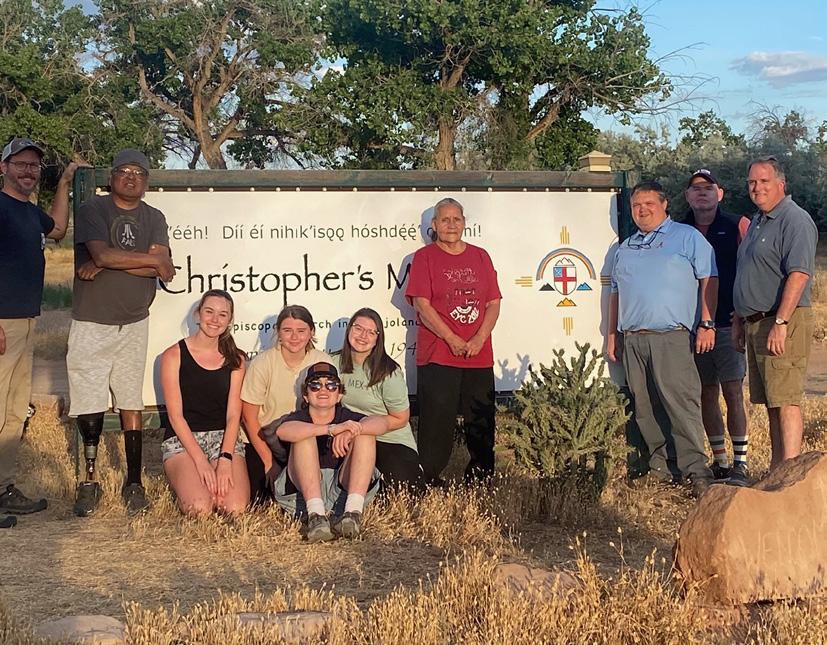
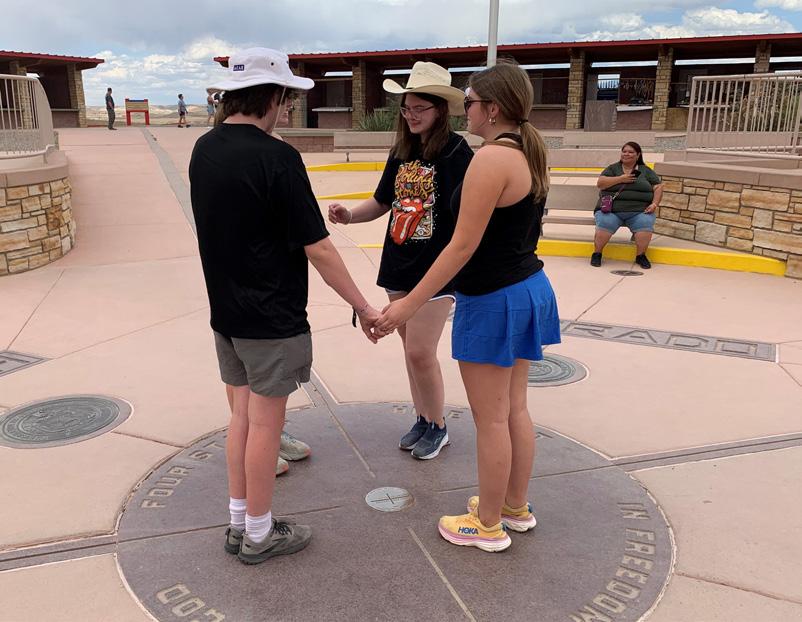 THE REV. DREW BRISLIN ASSOCIATE RECTOR, THE EPISCOPAL CHURCH OF THE ASCENSION, MONTGOMERY
THE REV. DREW BRISLIN ASSOCIATE RECTOR, THE EPISCOPAL CHURCH OF THE ASCENSION, MONTGOMERY
It was - and is - the hope that seeds of community and understanding have been planted not only within our youth but also in the participating adults. One of the members of St. Christopher’s commented to me that often groups visit and seem to do their own thing. Our desire to get to know them was well received and welcomed. They especially appreciated how our youth asked questions and engaged the community. They asked us to remain in contact and they would like us to return. They told us that now we are family.
The same God that crafted those incredible Utah mountains and sunsets, also handcrafted my life and yours. This simple reminder has completely changed my outlook on my life.
-Margie Anne Prescott
The Diné people are wonderful people, full of spirituality and traditions that opened our eyes to all the many ways God encounters us. Community is at the heart of Christianity, and as Episcopalians our liturgy begins with gathering to become the body of Christwe do not practice our faith alone, but with each other. I believe it is this synergy between the traditional beliefs of the Diné and our beliefs as Christians that have allowed the Gospel to take root in such a spiritual place. The seeds of community have been sown with the people of Navajoland, and I look forward to watching them bloom.
The mission trip taught me a lot of life lessons, including that you don’t always know what someone else is going through.
-Ryan Coker
Members of St. Christopher’s gathered with us to talk about their experiences growing up, and shared some of their traditions and spiritual beliefs. After a community meal we were blessed with the gift of hearing a local medicine man tell a story about growing food, followed by members singing a blessing for us in Diné. After dinner we were treated to more songs in the Diné language.
DIOALA.ORG 21
A Nuclear Physicist, a Grocery Clerk, and a Deputy Sheriff Went Into a Church…
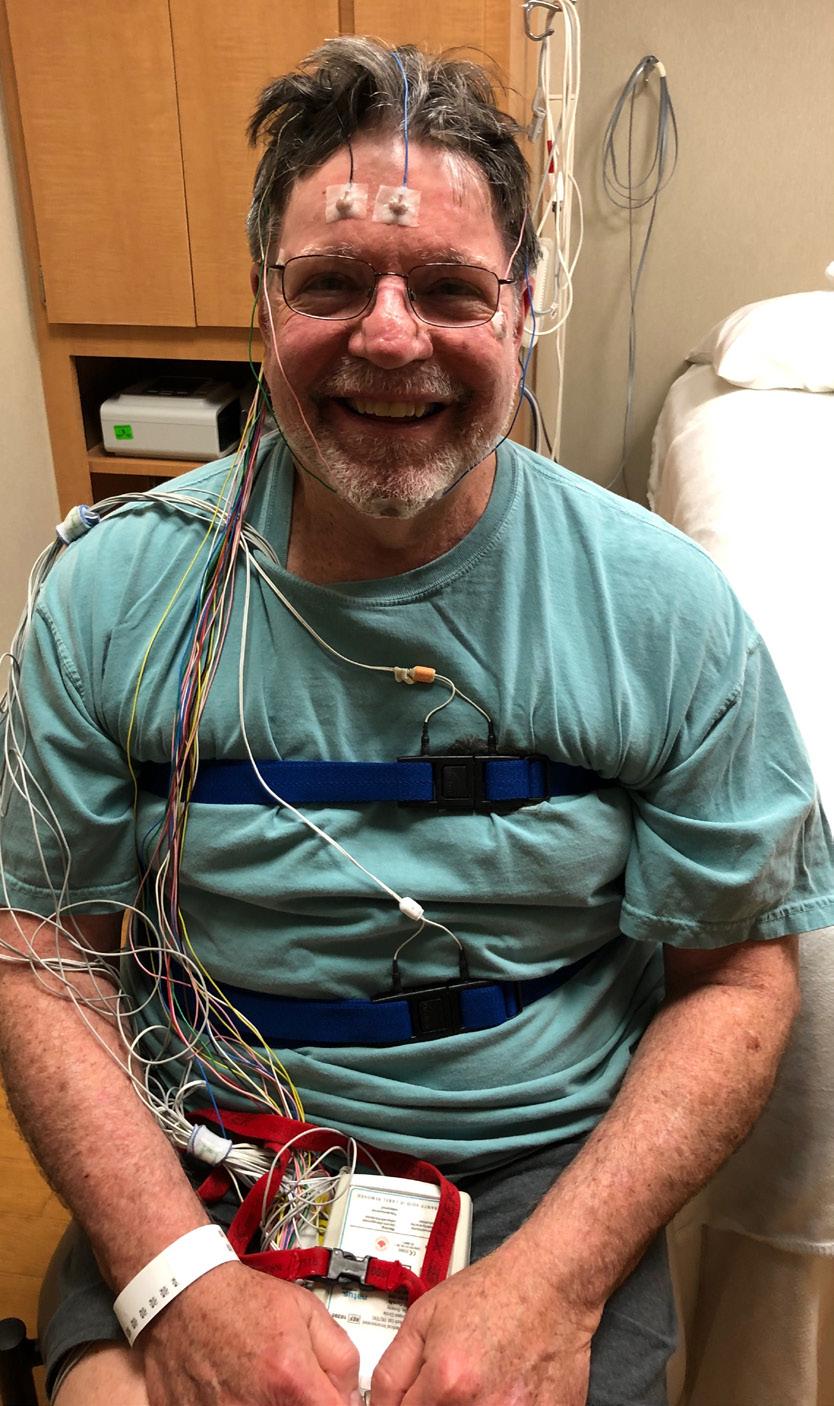 BY THE REV. MARTI HOMES, ARCHDEACON
BY THE REV. MARTI HOMES, ARCHDEACON
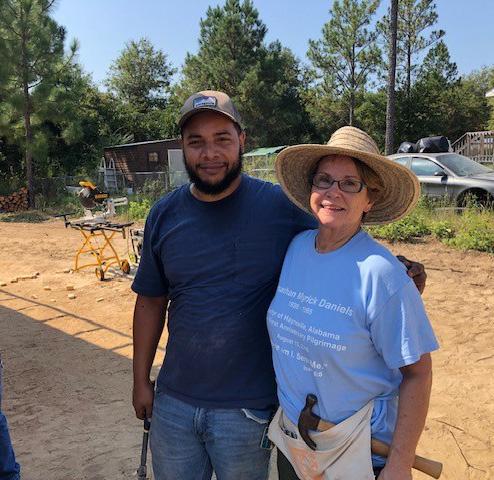
…and each answered a call to discern for a life in diaconal ministry. God calls a wide variety of people to serve in ministry, and that is clearly evident in the lives of deacons. Deacons are called to take the love of Jesus to the secular world, and to take the very human needs, concerns, and hopes of people to the church. To effectively carry out that ministry, they must necessarily be people with one foot in each place. Since the world is filled with diversity, it is natural that the order of ministry which serves as a bridge to connect the secular and the church be equally diverse.
It is the norm in the Diocese of Alabama for deacons to serve as non-stipendiary clergy, which means that, in most circumstances, they do not receive compensation for the work that they do for the church. It is the expectation that most will be employed in secular careers while simultaneously serving the church.
Deacons work in limitless settings with their vocational calls. When he was ordained, he was a professor of biology offering
Part 2: The Role of Deacons Where They Work
In the name of Jesus Christ, you are to serve all people, particularly the poor, the weak, the sick, and the lonely.
As a deacon in the Church, you are to study the Holy Scriptures, to seek nourishment from them, and to model your life upon them. You are to make Christ and his redemptive love known, by your word and example, to those among whom you live, and work, and worship. You are to interpret to the Church the needs, concerns, and hopes of the world. You are to assist the bishop and priests in public worship and in the ministration of God’s Word and Sacraments, and you are to carry out other duties assigned to you from time to time. At all times, your life and teaching are to show Christ’s people that in serving the helpless they are serving Christ himself.
22 THE EPISCOPALIAN
-The Ordination of a Deacon BCP 543
Deacon Robert Serio, MD is a sleep disorders physician. He’s pictured here experiencing what his patients go through.
to students an understanding of the care of creation, and he led the Outreach Committee at the parish. She is a nurse, caring for those who are ill, and teaches the Sunday Adult Forum at her assigned parish. She works in business leading others to understand how the best business practices always center on treating customers, vendors, associates, and others respectfully, honestly, and fairly, and she trains parish volunteers to be members of a pastoral care team to serve homebound members. He is a physician and leads a contemplative prayer ministry. She is a stay-at-home parent and leads the feeding ministry in her parish. He works in the science of energy production and plays in the parish praise band at parish and diocesan events. She works for a nonprofit social service agency and serves as an advocate for the poor at the local, state, and national levels. These are living examples of how deacons are living out their vows where they work.
The ministry of the deacon in the church is not limited to the parish setting. Most deacons are also active in diocesan commissions, committees, and ministries. Some serve the Episco-
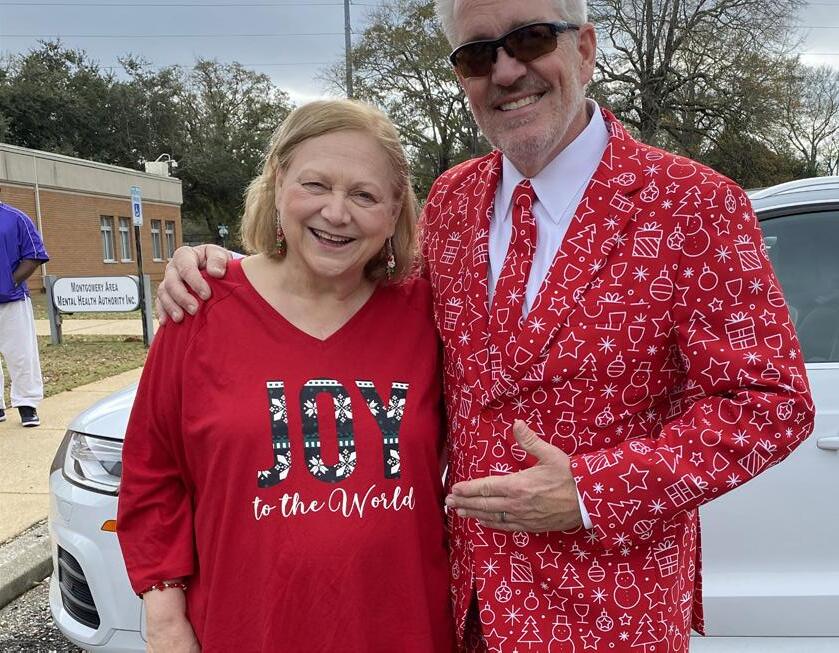
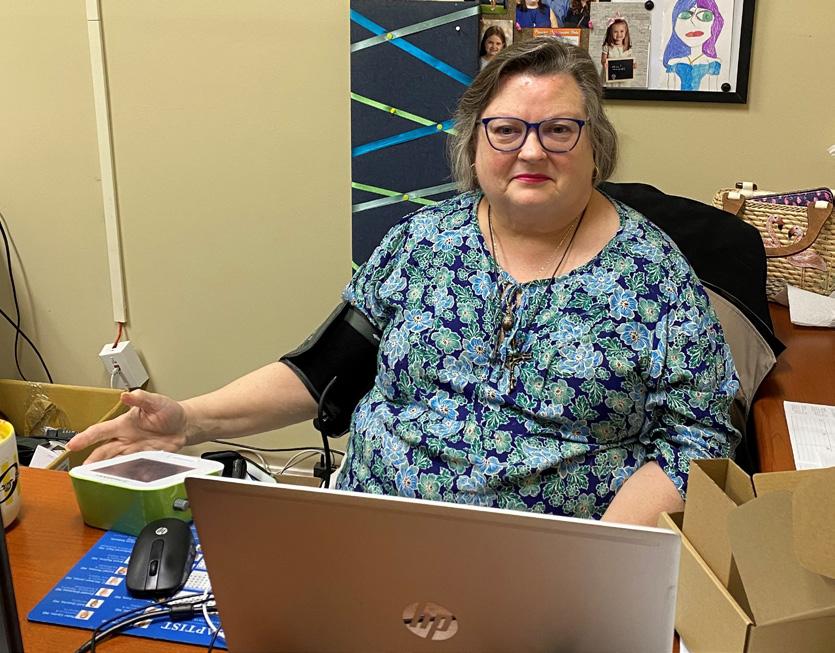
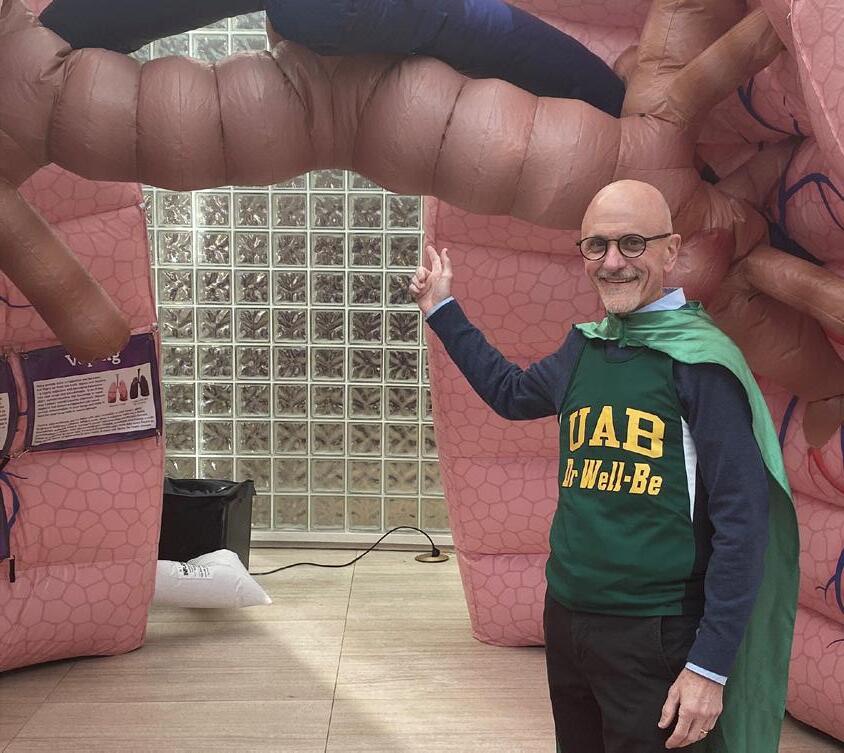
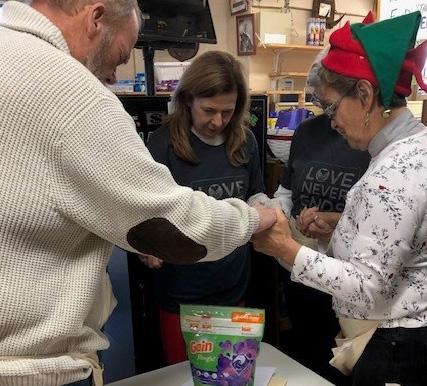
pal Church nationally or in global ministries. The work of deacons is as varied as the number of deacons – each offering their unique gifts and available time to God’s work in this world in a variety of secular and church work settings.
It is important to note that the work of the deacon is always focused on people – ALL PEOPLE. Rather than leading lives of continuous projects, activities, and services outside the realm of the community of the church, the work of the deacon is to help the people of the parish to become more and more aware of the interconnectedness of people, the needs of all people, and the development of a community that deeply values and honors all people - both inside the church community and outside of it. Deacons are the bridge that connects people - drawing more people to Christ and sending more faithful people out to love and serve. They make time to simply be with people.
If you would like to know more about deacons or are sensing a call to the ordained life of a deacon, talk to a deacon you know or contact Archdeacon Marti Holmes, mholmes@dioala.org.
DIOALA.ORG 23
Deacon Judy Neil delivering gifts to friends of Mental Health America in Montgomery.
Deacon John Kennedy, MD (aka Dr. Well-Be), is next to giant inflatable lungs during an event at The Kirklin Clinic to promote awareness of common lung diseases and treatments.
Deacon Catherine Schiesz works for a program called Remote Patient Monitoring. Patients are given a cuff to take home and get readings taken every day, so their doctors are able to monitor them daily. Catherine says “It’s a lot of fun and I get to visit with some lovely people.”.
Deacon Charlotte Van Dyke, praying with our Laundry Love volunteers in a neighborhood laundromat.
Earlier this year, folks from across the Diocese of Alabama arose early to travel to Montgomery for a race and reconciliation pilgrimage hosted by the Department of Campus and Emerging Adults. Several students from Birmingham, Huntsville, Florence, and Tuscaloosa campus ministries arrived by 9:15 a.m. at St. John’s Church in Montgomery for breakfast and a centering conversation led by the incredible Breanna Mitchell, Missioner for Racial Healing and Pilgrimage. During this conversation, we set our intentions on what we hoped we would get out of the experience, and discussed why we had originally decided to attend. Following our conversation, we walked over to the Equal Justice Initiative (EJI) Legacy Museum, where we spent most of the day learning about the history of racial injustice in America — from enslavement to mass incarceration. After enjoying a quick lunch at Pannie George’s, we caught the shuttle over to the National Memorial for Peace and Justice. We spent an hour or so walking around the sacred site in silent contemplation, reading the countless names of those who were lynched. The somber mood in the air was palpable. Many tears were shed and hugs were shared.
cillating feelings of anger, lament, and sorrow. To attempt to channel those thoughts into something productive and positive, we considered the possible ways in which we could carry what we learned from our pilgrimage with us into our lives and in our communities.
Race and Reconciliation Pilgrimage Reflections
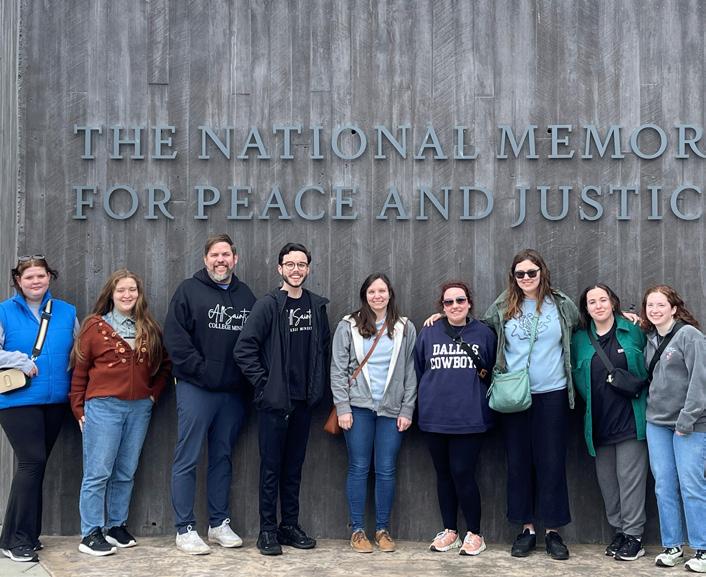 BY GAIGE TITTLE
BY GAIGE TITTLE
Upon returning to St. John’s later that evening, we embarked upon the holiest part of the day, our debrief conversation. I think I can safely speak for all pilgrims when I say it was an emotionally weighty day for all of us. This was especially true for those of us, like me, who had never visited these places. Hearing about these horrific stories secondhand pales in comparison to being directly confronted with them. Since we had a relatively small group setting, it was a conducive space for us to engage in such raw, vulnerable conversations. We took the time to share openly with one another about what we had seen, heard, and learned from that day. Many expressed os-
To conclude our time of reflection, we prayed a shortened version of evening prayer together. One person powerfully read the Parable of the Good Samaritan from Luke’s Gospel in its entirety, and we offered our thoughts on how this central lesson of Jesus’ ministry relates to what we experienced that day. Our closing litany was adapted from Martin Luther King, Jr.’s prayer entitled “Shake Us from Our Slumber.” I think his final words in that piece perfectly encapsulated the essence of the day: “Ever present God, you called us to be in relationship with one another and promised to dwell wherever two or three are gathered. In our community, we are many different people; we come from many different places, have many different cultures. Open our hearts that we may be bold in finding the riches of inclusion and the treasures of diversity among us. We pray in faith. Amen.”
This pilgrimage to Montgomery was an incredibly powerful one. I think it’s no coincidence that it fell on the lesser Feast of Cyril of Jerusalem, a 4th century bishop credited with making Jerusalem the pilgrimage center it is today for Christians around the globe. It turns out that we don’t have to venture far to take pilgrimages to holy, hallowed grounds. We have ample opportunities in our own backyard — in Montgomery, Hayneville, Selma, and more. Like the Good Samaritan, we as followers of Jesus are called to do our part to help those who are hurting in this world. We know that we cannot grow if we choose to remain comfortable, so we must intentionally enter into places of discomfort with the hope of learning. “The first duty of love is to listen,” wrote Paul Tillich. I think that’s right. Thanks be to God for the gift to listen.
Gaige is a third-year student at the University of North Alabama, is the campus ministry leader for the Canterbury UNA program, and is a postulant for Holy Orders in the Diocese of Alabama.
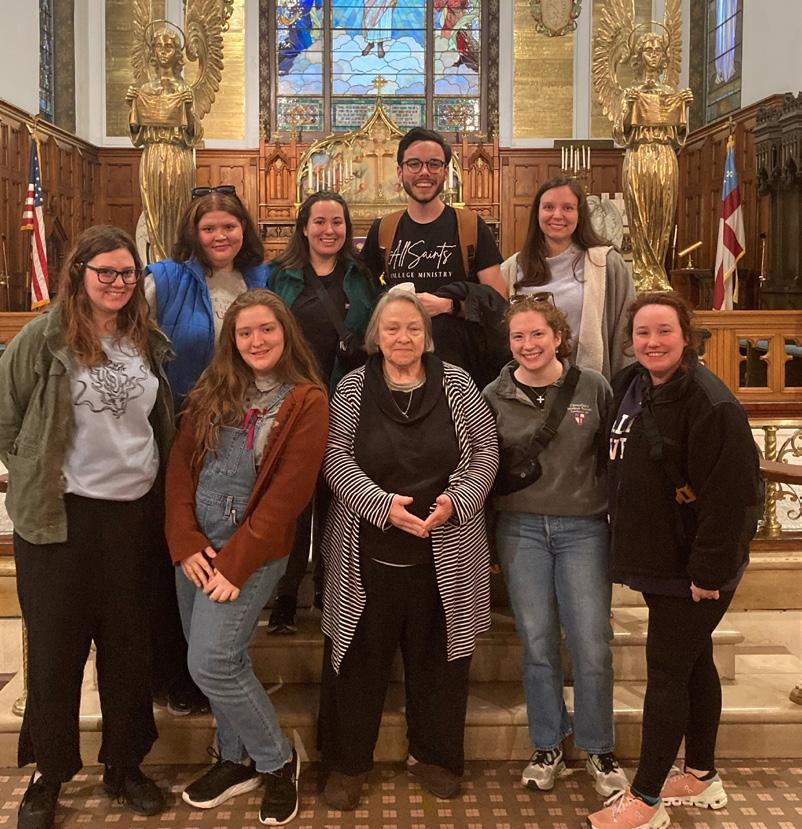
24 THE EPISCOPALIAN
Kenya Relief
BY LAUREN EICH
I don’t think anyone is more surprised than me that I am a missionary to Kenya. I’m a member of St. Matthew’s Episcopal Church in Madison, Alabama, and I am working in Kenya at a children’s orphanage doing art and art therapy activities. This is my first trip as the Missionary Child Sponsorship Coordinator at Kenya Relief, an organization based out of Cullman, Alabama.
Much of my initial understanding about mission work came from hearing my grandfather, the Rev. Dr. Foster Eich, Priest Associate at St. Bartholomew’s Episcopal Church, Florence, telling stories about his medical trips to Haiti. I first heard about Kenya Relief through my parents, Dr. Mark and Jann Eich, members at St. Matthew’s Episcopal Church, who have traveled with teams through Kenya Relief since 2018. I’ve been able to take part in their medical teams for the last two years.
Kenya Relief has a 60-acre property in Migori, Kenya on which they run a medical clinic, children’s home, and a school. They have been taking over 20 teams to Migori each year for almost 20 years, and the short-term mission teams help with education, outreach, and medical/surgical care. The children’s home, Brittney’s Home of Grace at Kenya Relief, serves around 80 children, and the school serves nearly 800 children.
Hopefully I’ll be spending six months a year on campus in Kenya, and when I’m in the U.S. I’ll work at the office in Cullman to connect with sponsors and fundraise for different needs that the kids have. While in Kenya, I will be doing art activities with the 80 or so pre-school to sixth grade-aged children that live at the children’s home.
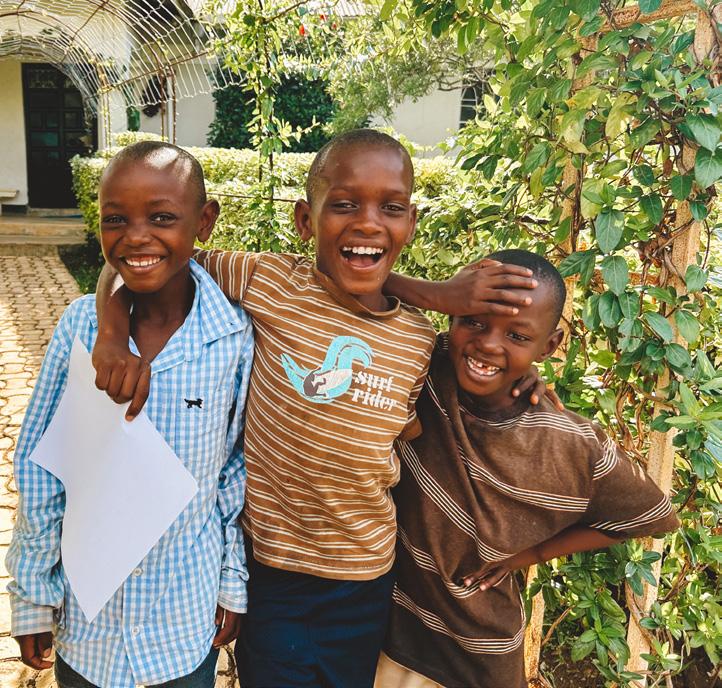
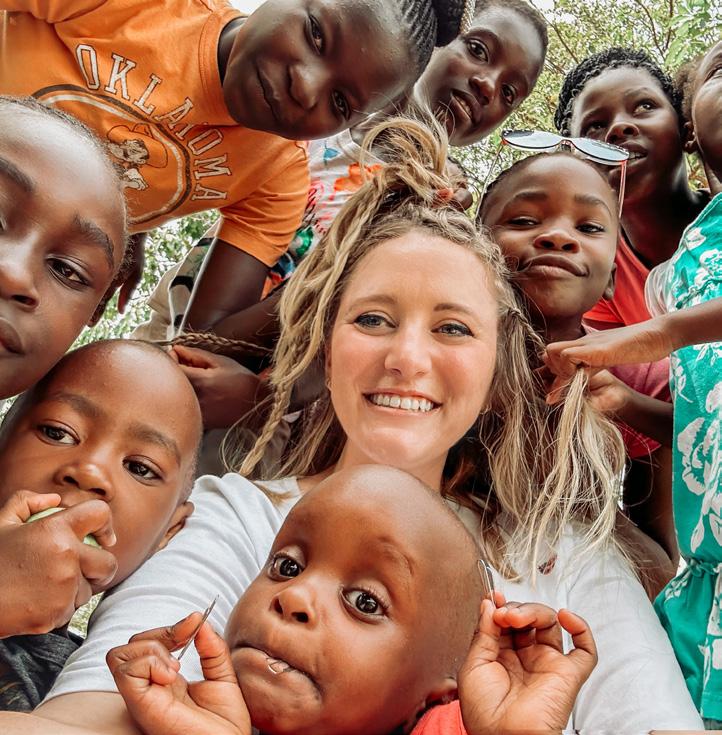
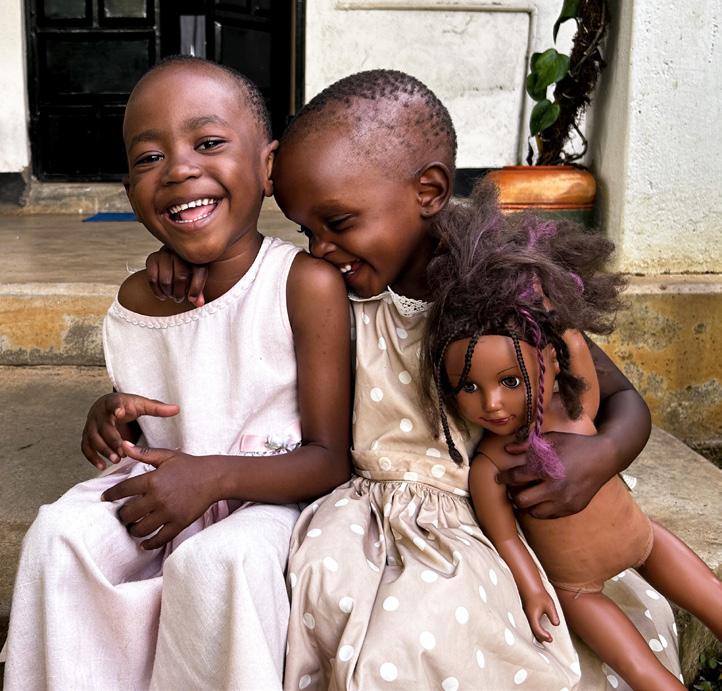
For more information supporting about Kenya Relief visit their website, www.kenyarelief.org. You can reach me at childsponsorship@ kenyarelief.org!
This year I spent a week with our Fantastic Team Five, made up of several families from St. Matthews, and Andrew Ault from Ascension Episcopal Church, Birmingham. Andrew and I met at Vocare, and I’m so thankful for the impact that the Vocare community had on my formative years as a young adult - as a pilgrim in 2012 and then as staff in 2013, 2014, 2018, and 2019. That sense of community has helped guide me as I’ve made the decision to accept this call to work as a missionary, helping to build and encourage community between teams that travel 8,000 miles to Kenya and the staff & the children that live there.
Vocare is a weekend of reflection and relaxation in an inclusive, supportive, Christ-like community, and is open to any young adult who is searching for God’s plan for their life. The traditional age range for those attending is 18-30. It is an intentional and deliberate time of renewal away from the congestions and confusions of daily life to discern your calling. You don’t have to be Episcopalian, from or live in the Diocese of Alabama, or identify as really anything at all to attend, but an open heart and mind are encouraged. Vocare is a weekend all about YOU and it can be whatever you want it and make it out to be. Questions? Contact Jen Manning, Missioner for Youth, Campus, and Young Adult Ministries, jmannning@dioala.org
25
DIOALA.ORG
From Sewanee to Selma:
Relationships and a New Journey Together
BY LAUREN GOODPASTER, DIRECTOR OF OUTREACH & SERVICE-AWAY PROGRAMS AT THE UNIVERSITY OF THE SOUTH
Sewanee has a long tradition of immersing students in communities near and far in short-term service opportunities. For years, Sewanee students and community members have worked together, hand in hand, to learn one another’s stories and to complete volunteer projects in order to make a difference in the community. When we were looking for a new service opportunity, I felt pulled to create partnerships with communities that are more like Sewanee - communities with significant history in regards to slavery and race relations. I wanted us to enter into a sustainable relationship with a community where we could work together for years to create positive change in each other’s lives.
In 2022, Brian Cole, the Bishop of East Tennessee, took a group of parishioners on a pilgrimage to Selma, Alabama and he couldn’t stop talking about what a transformative experience it was. By the end of the conversation I had with him, it was clear that Selma and her people were just what I had been looking for in a new community and partner for my work with students at Sewanee.
My first visit to Selma was in May of 2022, followed by another in October 2022. We launched our first spring break outreach trip to Selma in March 2023. Nine of us loaded up in two vans on March 10th and made the almost five-hour drive from Sewanee to Selma.
Upon our arrival, we were greeted with open arms by Rev. Amy George, Rector of St. Paul’s Episcopal Church. We were delighted and honored to be the first official group to stay at the newly renovated “Common Ground”, known to most as the Gamble House, owned and operated by St. Paul’s Selma. Amy and the church’s vision for the space could easily be recognized in the care they put into the renovations.
Our work throughout the week involved both hands-on service as well as deep learning and engagement with local community members. We were fortunate to be connected with the Edmundite Missions, and throughout the week, we volunteered with their Bosco Nutrition Center. Equally important work was beginning to build relationships with community members from different parts of Selma. At the end of every day while we were there, we came back to Common Ground, our “home away from home”. We often had dinner waiting for us, cooked with love by members of St. Paul’s. And as we kicked off our shoes, we were grateful for the space to gather every evening to reflect on our day. Sometimes we spent time together in the parlor, deep in discussion about what it means to live in community and what it also means to build trust in new community relationships. Sometimes we needed quiet time to individually process what we had experienced throughout the day, and the space was perfect for that. Whether outside on the porch or inside one of the many gathering spaces, we felt comfortable and grateful to have a space to settle into each night.
I am looking forward to our next trip to Selma, and I can’t wait to introduce students to the new friends I have made there, to the places where we can learn more about our country’s Civil Rights Movement, and about the resiliency of Selma’s people. And of course, I can’t wait to be welcomed back “home” to Common Ground and share in its hospitality with many more Sewanee students.

26 THE EPISCOPALIAN

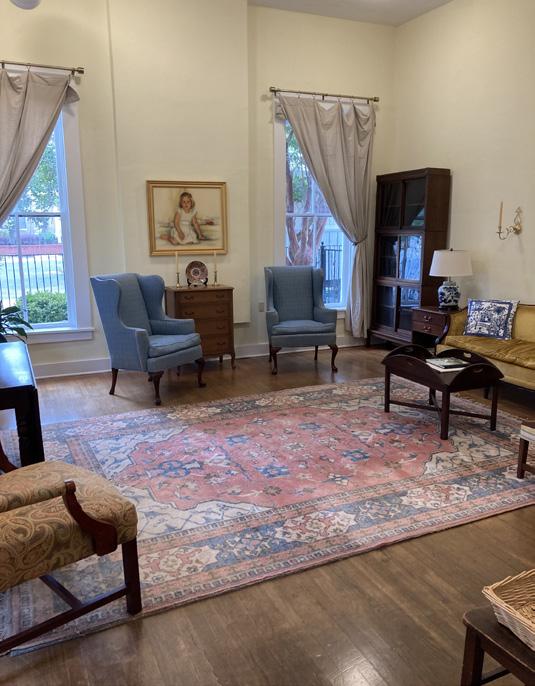
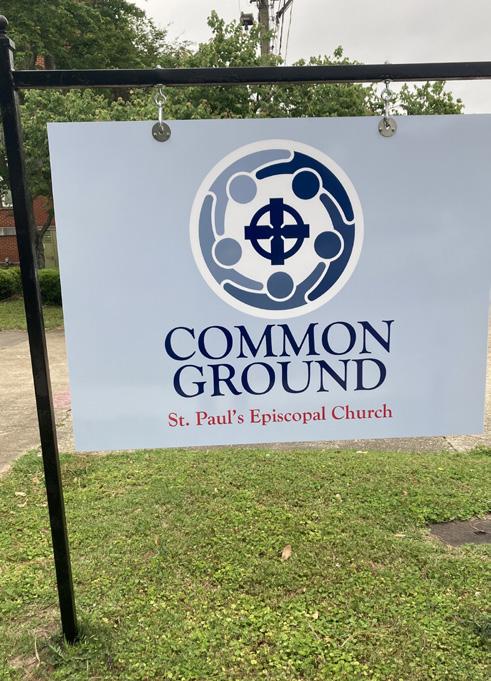
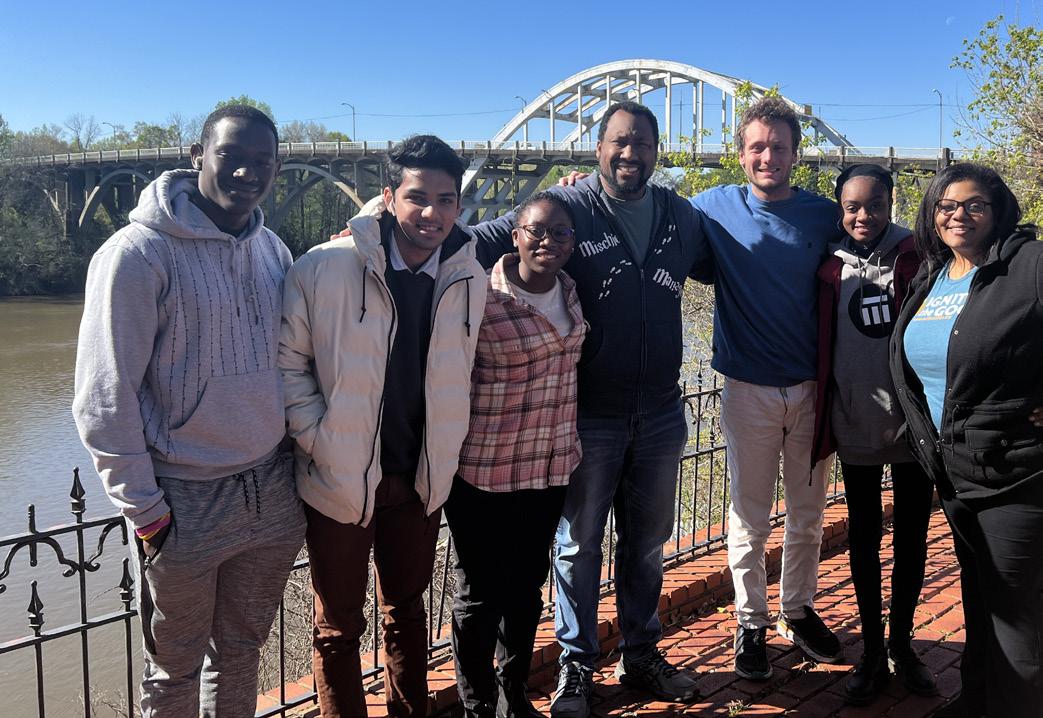
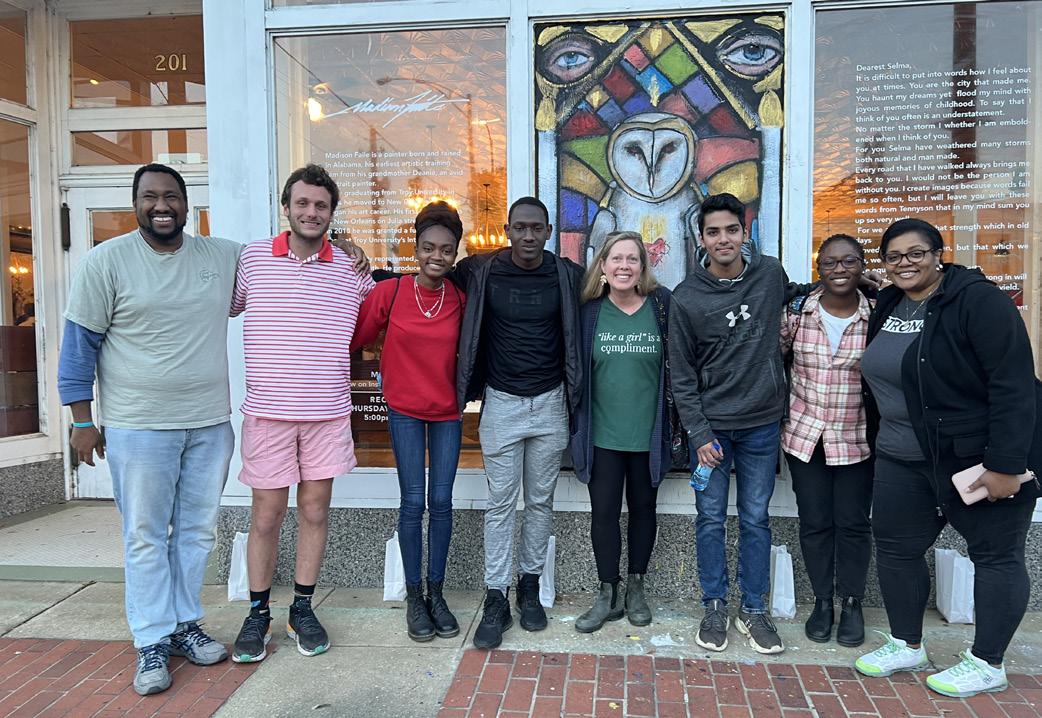
DIOALA.ORG 27
Rolling Out the Red Carpet for 25 Years of Special Session
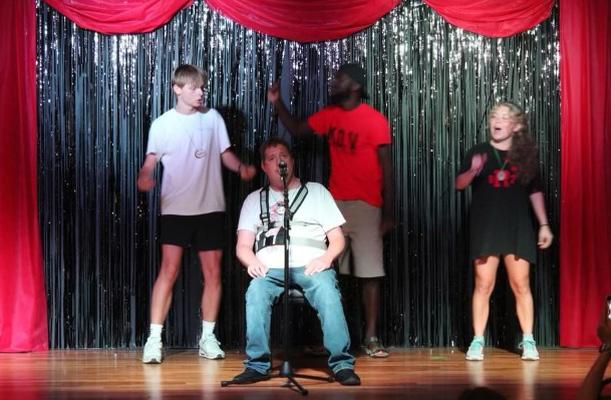 BY THE SPECIAL SESSION STEERING COMMITTEE
BY THE SPECIAL SESSION STEERING COMMITTEE
Twenty-five years ago, a group of parishioners from St. Thomas Huntsville organized the very first “Special Session” at Camp McDowell. They had been hearing from Kee Sloan, their rector at the time, preach about his experience at a camp for folks with disabilities in Mississippi. Finally they asked him after church one Sunday when he was going to quit talking about it and make it happen in the Diocese of Alabama. That summer, a small group of folks, mostly from St. Thomas, started what would become one of the most formational ministries our diocese offers. Over the years, we have grown from having 25 campers to over 100. Over one thousand high schoolers, college students, and adults have served on staff, many of them returning year after year. Some of the people who started coming as teenagers still serve on staff today and bring their children with them.
This past June, we celebrated our 25th Anniversary by “Rolling Out the Red Carpet”. Our activities and decorations were themed to make everyone feel like they were Hollywood royalty. Campers and counselors got to dress up in their most glamorous attire, everyone received a fancy academy award before the “big dance”, and we had a very special Lifetime Achievement Award presented to Sam Herman, the only person who has been at all 25 sessions.
“This session shaped the values I hold dearly now and instilled in me tenets that focus on justice, acceptance, and radical care for other people. I’m so grateful it exists.” Grace Mullen
Lillie Hartley, Chair of the Youth Department, had this to say about Special Session: “I have been a part of the Special Session community since I was six years old… This past year was my second year as a counselor, and even though there are tough moments, the experience and the friendships made are life-changing. Special Session allows everyone involved to see how the world truly should be.”
Many things happen at Special Session. We spend time doing regular campy things like swimming in the pool, doing arts & crafts, making pottery, playing games, and going on hikes. We
have silly evening activities like Banana Olympics and host a big Talent Show where campers get to show off their singing skills, show everyone their powers of hypnotism, or play beautiful tunes on the piano. But what really makes us special is the building of a community of unconditional love and acceptance that happens in between these “big” moments of activity. Sitting and visiting in a rocking chair for Quality Porch Time. Helping someone during a meal. Leaning on a new friend because you are exhausted and need someone to talk to. We are more than just a week of playing and sweating in the hot Alabama heat. We see, acknowledge, and celebrate our differences. We are a year-round community of love and support. Many of our staff members are each other’s best friends. We are attendants in each other’s weddings. Each other’s first phone calls when something really good or really bad happens. We do life together because we have been formed together in a beautiful community that embraces every participant’s full humanity. Grace Mullen, one of our session directors said, “This session shaped the values I hold dearly now and instilled in me tenets that focus on justice, acceptance, and radical care for other people. I’m so grateful it exists.” We are grateful, too, and are looking forward to twenty-five more years of spreading the Gospel of Radical Inclusion.
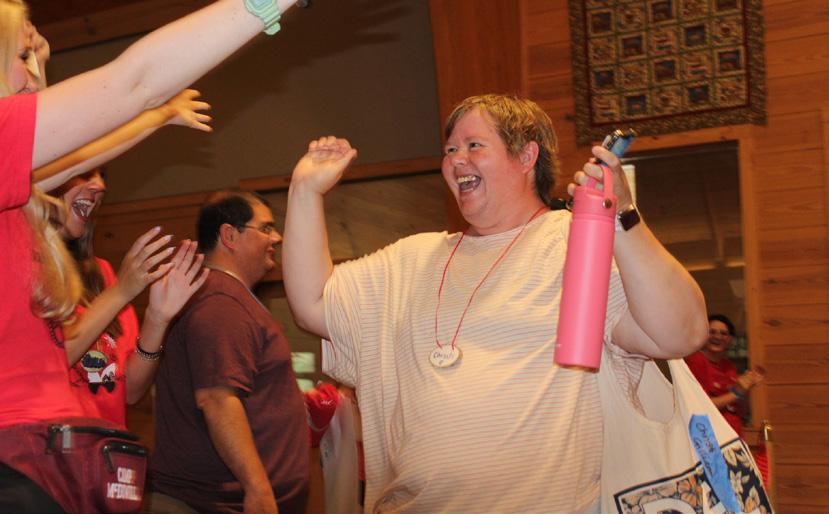
28 THE EPISCOPALIAN
“Young People Paint Birmingham” Returns!
BY JANN EICH, YOUTH MINISTER ST. MATTHEW’S, MADISON
This year, Young People Paint Birmingham finally returned after a several-year hiatus due to the Covid-19 pandemic. YPPB is a week-long service project for Jr. High students from across the diocese. We partner with the Joe Rush Center of Urban Ministry to paint the exterior of a house in West Birmingham. Joe Rush provides the paint, supplies, and knowledgeable painting staff and the diocese provides hard-working volunteers! Below is a reflection from the event lead, Jann Eich:
Summer. July. Alabama Heat. Not many would take these conditions and volunteer to scrape and paint a house! We had several teens who not only braved these conditions but gave up a week of their summer vacation just before school started. Our team was assigned to an elderly couple that needed their house painted. The youth worked hard scraping and painting, most of the time on ladders, and the chaperones worked right along with the teenagers to finish painting the house in just three days.
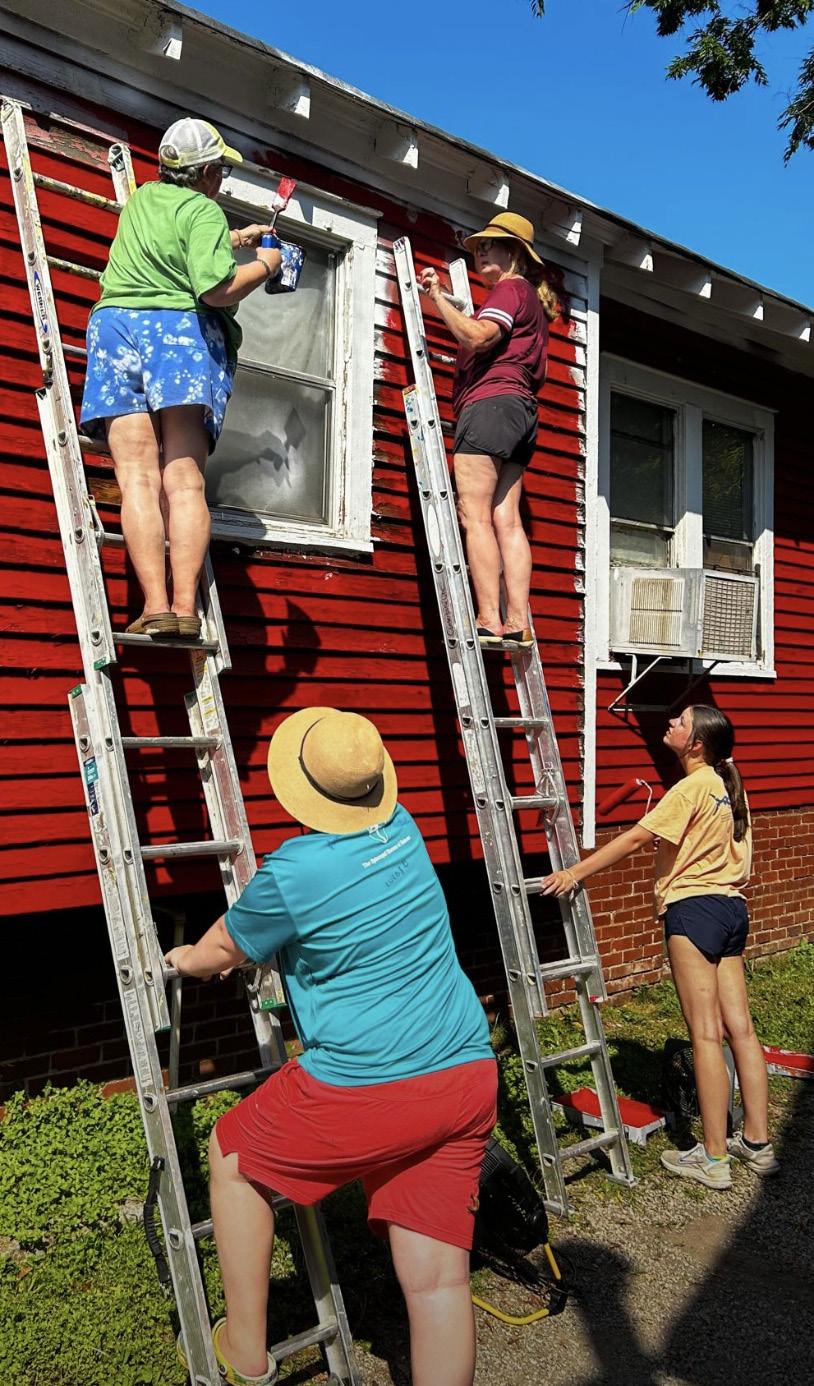
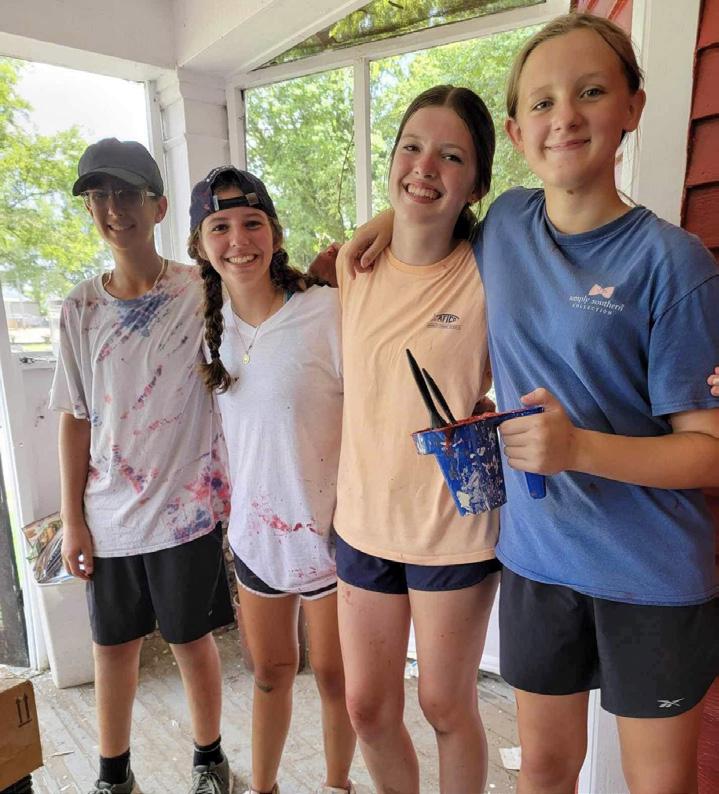
Lottie Pound, who participated in YPPB as a Jr. High student and is now in high school, served as a “counselor in training” for the week, and said “YPPB has developed me in many ways
by teaching me new skills, helping me see that I can do more than I think I am capable of, and made me realize that meeting new people is not as scary as it may seem. This is an experience that I think everyone should go through because it teaches us about working really hard to help improve a strangers life. It definitely takes patience and to look at the bigger picture. I felt like I made an impact and that feels good!”
Special thanks to Urban Ministry, Jen Manning at the diocesan office, St. Stephen’s, Birmingham and their staff for housing us, All Saints, Homewood for letting us use their church bus, Marcy and Kevin Camp for cooking for us, and Mountain Brook High School for letting us use their facilities to shower. It takes a village to put on this important week of service and we were well cared for while we worked hard being the hands and feet of Jesus in our community.
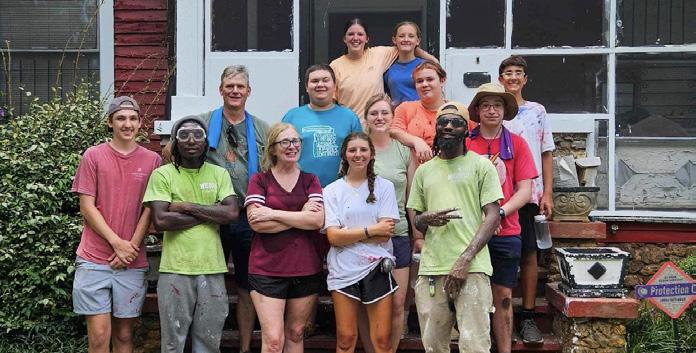
29 DIOALA.ORG
When God Calls and You Answer: Reflections on a Sawyerville Summer
BY KANA GOLDSMITH, INTERIM DIRECTOR OF SAWYERVILLE

Have you ever answered the phone with no name attached to the caller? Most of the time I don’t, I let it go to voicemail and sort it out later. But for some reason in February, maybe due to being cooped up in the house due to the cold weather, I answered a call with no caller ID. On the other end of the line, was the soft-spoken voice of Kelley Hudlow. It didn’t take long for her to get to the point. It was a simple question. “Would you consider being the Interim Director of Sawyerville?” Equally as startling as answering the call in the first place was my response: yes.
It has always been my policy in life when people ask you to do things or to show up, that you answer with yes. After all, they are asking you because they have thought about you, which should make one wonder why. Not every ask is met with fulfillment on my part. But I have said yes to Sawyerville since Susanna Whitsett was Director. It started with my husband driving to Sawyerville to play music for the camp, later it was Leslie Manning who asked us to write the program, and then Crystal and Claire who emailed summer after summer to serve on staff in some way. We always answered Yes. Our children, Thomas, Gus and Sara Margaret have all been campers and served on staff. So, when Kelley Hudlow
It’s All About Love
“It’s All About Love,” a churchwide festival of worship, learning, community, and action for the Episcopal branch of the Jesus Movement, was held July 9-12, 2023 at the Baltimore Convention Center. Several clergy and lay people from our diocese attended, including the Rev. Danny Whitehead, who wrote the following about his experience at the festival.
The focus of the festival was on evangelism, racial reconciliation, and creation care. Influenced by Care of Creation, there were no worship bulletins. The opening service reminded me of our Diocesan Revival held in May 2022 at Birmingham-Southern College, and included upbeat music, unique prayers, motivational/testimonial talks, and the highlight of the event, Presiding Bishop Michael Curry. Due to his medical issues, he was only there for the opening. Of course, the theme of his sermon was LOVE, shared powerfully despite him saying he couldn’t be as physically active as he usually is. After citing Fannie Lou Hamer, he went on to quote Jimmy Hendrix “the power of love overcomes the love of power”.
Monday’s session opened with a powerful presentation by my former theology professor Kwok Pui Lan on racial reconciliation.
asked, I knew the answer and I knew the change in my life that would occur.
For me, this summer has been an affirmation that when God calls and you answer, God will sustain you. Every anxiety was met with a person who rounded the corner with the answer. Literally. And I called on my closest friends for support, Leslie Manning, Susanna Whitsett and Allison and Kathryn Kendrick. And they showed up, guiding me, lifting me up to do this task - and it was beautiful. Sawyerville, like any camp, had all the bumps in the road, from tornado warnings to an outbreak of the stomach bug. But every time, the thing you least expected, or what I call “the least grateful moment”, God was there. I knew people were praying not only for me but for every camper and staff person associated with Sawyerville. When you walk the halls of Greensboro Elementary you can feel the presence of the Lord. It is undeniable and that’s why people keep coming back.
I encourage every member of the Episcopal Church in Alabama to take a pilgrimage down State Road 69. Take a right at the Dollar General and turn up the windy drive to Greensboro Elementary School, because when you do, you will be changed. Like Pastor Kervin Jones is fond of saying, Greensboro is the center of the universe.
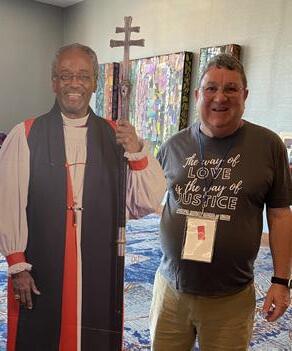
Throughout the day, various workshops were offered. Revival Worship, featuring Rev. Mariana White-Hammond and the Live Hymnal Band, closed the day with energetic hymns, echoing the theme of “Care of Creation.”
On Tuesday, morning worship highlighted climate concerns through the voices of three very informed youth, aligning with the festival’s environmental focus. After that, I shifted my attention to conversations about the future of my seminary, Episcopal Divinity School, as alumni gathered to honor the past and envision new possibilities. A workshop on interpreting the Bible through the “Beloved Community Lens” offered fresh perspectives. At dinner I joined other EDS alumni at Ground Work Kitchen, a full-service restaurant and social enterprise that provides job training for those formerly homeless. The evening worship service was led by speaker Sarah Augustine, and underscored the global impact of environmental exploitation on Indigenous communities around the world.
Due to Presiding Bishop Michael’s absence, Jerusalem Greer and practical theologian Brian McLaren discussed the Episcopal Church’s future, emphasizing its role in addressing loneliness and despair exacerbated by the pandemic. The closing worship service was a Holy Eucharist presided over by Bishop Gene Robinson, with Julia Ayala Harris, President of the House of Deputies preaching a rousing sermon. More great music and sending prayers continued the theme of the Festival – LOVE.
To learn more about the festival go to https://www.episcopalchurch. org/its-all-about-love.
30 THE EPISCOPALIAN
The 193rd Convention of the Episcopal Diocese of Alabama will be held in Montgomery, Alabama, on Feb. 8-10, 2024. The meeting will be held at the Renaissance Hotel in downtown Montgomery.
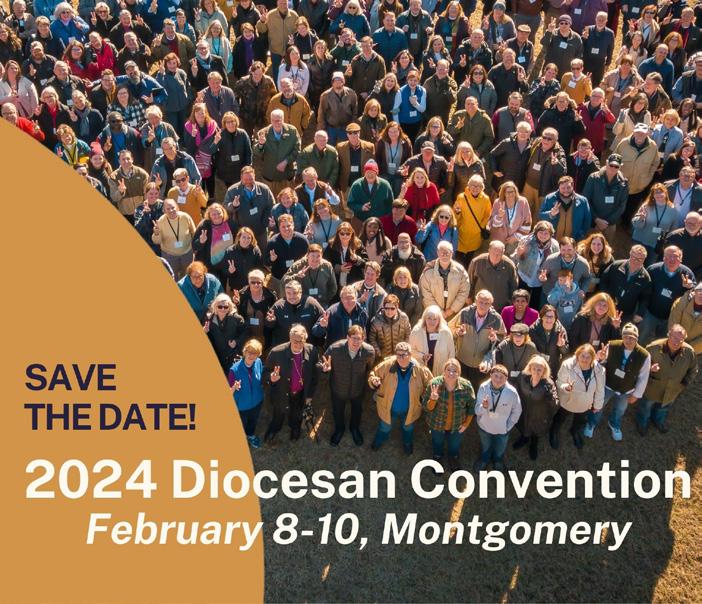
Blocks of rooms have been reserved at the Renaissance Montgomery, Staybridge Suites Downtown, and the Doubletree Downtown. More information will be sent to parishes and included in diocesan publications in September.
Diocesan Staff Changes
Bishop Curry is pleased to announce the addition of Ms. Elizabeth Blake and Ms. Dara Miller to diocesan staff. Ms. Blake now serves as the Executive Assistant to Bishop Curry, replacing Ms. Liza Lee Horton.
Elizabeth is originally from Indiana but has lived in Alabama for more than 35 years. She and her husband, Britt, live in Hoover with their dog Dakota. Her son, Drew, lives in Birmingham. Elizabeth comes to the diocese after a long career as a Legal Assistant, and is excited to get to know the parishes and join Bishop G’s team. She joined staff on July 24, and can be reached at eblake@dioala.org.
Ms. Horton now manages the new diocesan database and serves as Assistant to Canons Evans and Hudlow. She can be reached at lhorton@dioala.org.
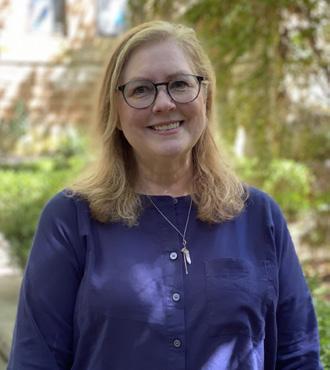
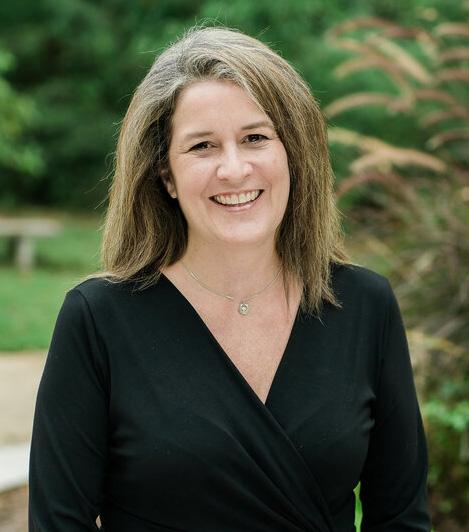
Hello, friends.
Tina, McKee and I want to write a short note to thank you for your cards, calls, casseroles, flowers, visits and emails after Mary Nell’s death in January, and thank you to those who realized that we were overwhelmed and simply offered your prayers. We thank all of you who made contributions to the Mary Nell Sloan Special Session Scholarship Fund; she loved that session at Camp McDowell and that remarkable, loving, inclusive community. It has been a terribly difficult time for us, but it would surely have been so much worse without the love and support of our friends and family. Thank you all.
We are all right; coping with this loss is an every-day struggle, but we’re hanging in there. I miss seeing all of you Sunday by Sunday, but I’m enjoying retirement, and grateful that I can be home with Tina.
Thank you, friends. Hug the people you love every chance you get.
God’s Peace, Tina, McKee and Kee Sloan
Dara Miller has joined diocesan staff as the Director of Finance and Administration. Dara comes to us from Holy Trinity, Auburn, where she has served on staff for the past 18 years in various roles including Bookkeeper, Financial Administrator, and most recently as Director of Parish Operations. Originally from Atlanta, Dara attended Auburn University and was confirmed at St. Dunstan’s as a college student; she began attending Holy Trinity in 1996. “The Episcopal Church has molded who I am as a person, and has provided a wonderful avenue for me to serve God’s people. It’s an honor and a privilege to serve our entire diocese and I’m grateful to Bishop G for this opportunity,” Dara said. “I look forward to building new relationships with our congregations and supporting our parishes, as well as maintaining the strong history of fiscal responsibility within the Diocese of Alabama. I am thankful for and indebted to Rob Morpeth for all he has done to ensure that this diocese is not only fiscally sound but also poised to step into a vibrant, promising future.” Dara began work in the diocesan office on July 24 and can be reached at dmiller@dioala.org.
DIOALA.ORG 31
The Episcopal Church in Alabama
521 North 20th Street
Birmingham, AL 35203–2682
The Episcopal Church in Alabama
Carpenter House
521 North 20th Street
Birmingham, AL 35203–2682
Bishop: The Rt. Rev. Glenda S. Curry
Assisting Bishop: The Rt. Rev. Brian N. Prior
The Alabama Episcopalian
Debbie Donaldson, Editor
Miles Parsons and Debbie Donaldson, Art Directors
Volume 108, Number 3
3rd Quarter, 2023
USPS 070-910
ISSN 1041-3316
Periodical postage paid
POSTMASTER: Please send address corrections to Liza Lee Horton, The Alabama Episcopalian, 521 North 20th Street, Birmingham, AL, 35203-2682.
The Alabama Episcopalian is published quarterly. Please send stories and photographs (full color, at highest resolution possible) to Editor Debbie Donaldson, ddonaldson@dioala.org. The submission deadlines for each issue are February 1, May 1, August 1, and November
1. Parishes and individuals, please send all address changes or additions to Liza Lee Horton, lhorton@ dioala.org or Carpenter House, 521 North 20th Street, Birmingham, AL 35203–2682.
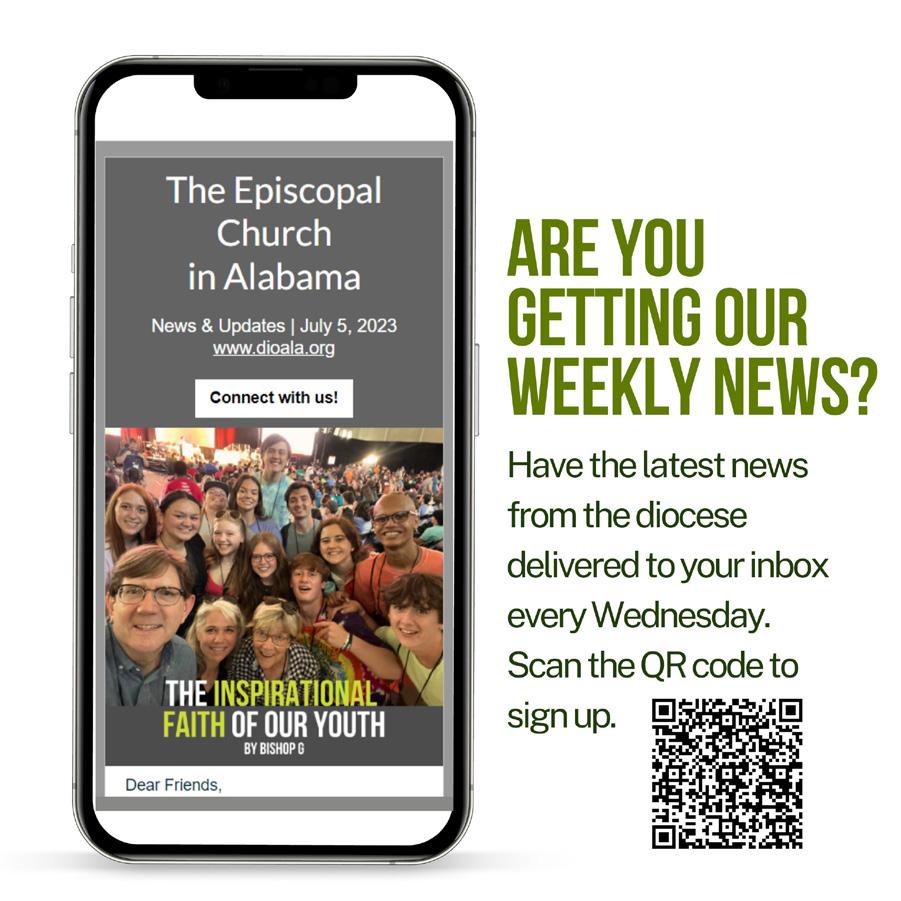

























 Article photography by Hugh Hunter Photography Learn more about the Many Color Arts Collective by scanning this QR code.
Article photography by Hugh Hunter Photography Learn more about the Many Color Arts Collective by scanning this QR code.













 The Rev. Katie Nakamura
Caption
Celebrating the Eucharist at The Abbey, in the fellowship hall of Zion Spring Baptist Church.
The Rev. Katie Nakamura
Caption
Celebrating the Eucharist at The Abbey, in the fellowship hall of Zion Spring Baptist Church.







 Carolyn Foster serving the chalice during communion.
At left: Jonathan Daniels while attending Virginia Military Institute.
Below: Pilgrims pause in front of the site where Jonathan was killed.
Carolyn Foster serving the chalice during communion.
At left: Jonathan Daniels while attending Virginia Military Institute.
Below: Pilgrims pause in front of the site where Jonathan was killed.




 THE REV. DREW BRISLIN ASSOCIATE RECTOR, THE EPISCOPAL CHURCH OF THE ASCENSION, MONTGOMERY
THE REV. DREW BRISLIN ASSOCIATE RECTOR, THE EPISCOPAL CHURCH OF THE ASCENSION, MONTGOMERY
 BY THE REV. MARTI HOMES, ARCHDEACON
BY THE REV. MARTI HOMES, ARCHDEACON





 BY GAIGE TITTLE
BY GAIGE TITTLE










 BY THE SPECIAL SESSION STEERING COMMITTEE
BY THE SPECIAL SESSION STEERING COMMITTEE









